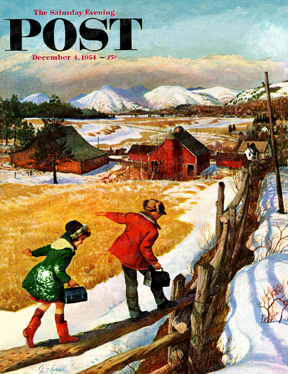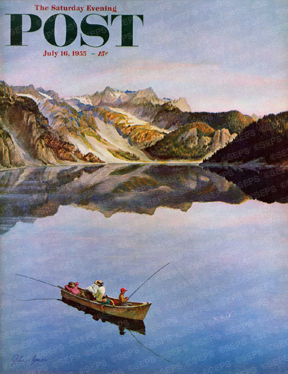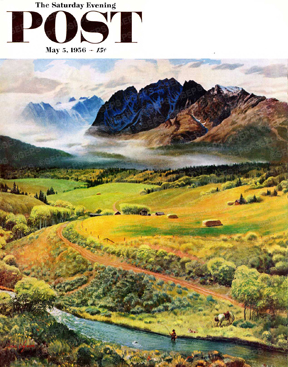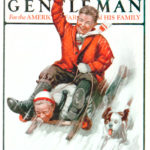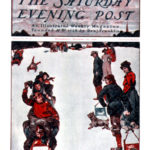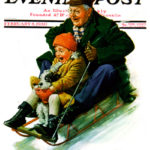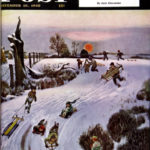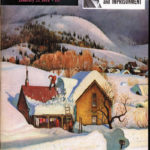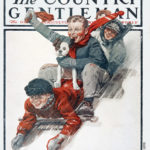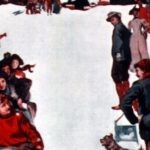Defending Freedom of Speech — Even When You Hate What Some People Wish to Say
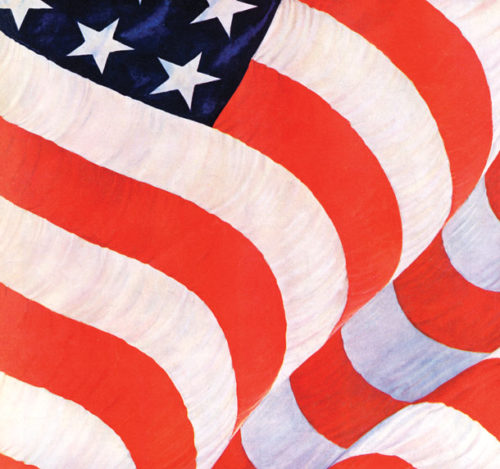
In a 1943 decision, the Supreme Court held that Americans weren’t required to pledge allegiance to or salute the flag. The editors lauded the opinion on behalf of the Jehovah’s Witnesses, and all Americans, whose loyalty cannot be commanded.
The principles of Jehovah’s Witnesses can be pretty annoying to the majority of citizens. They insist on propagating their beliefs at the most inconvenient times and places, and they make no concessions to the sensibilities of the majority. To our way of thinking, this makes all the more impressive the action of the court, taken in time of war, when hysteria can so easily be directed toward eccentric minorities.
The majesty of the flag will not suffer because it has been permitted to remain the symbol of a willing loyalty. The flag, which symbolizes our hard-won privileges, waves more proudly than before over the land of the free. Love of country is not in danger. It springs, to quote Justice Douglas, “from willing hearts and free minds.”
—“Score for Freedom, No. 2,” Editorial, July 10, 1943
This article is featured in the July/August 2018 issue of The Saturday Evening Post. Subscribe to the magazine for more art, inspiring stories, fiction, humor, and features from our archives.
Cover Collection: Baseball
From luminaries like Stan the Man and Yogi Berra, to kids playing sandlot ball, The Saturday Evening Post knew no equal when it came to great baseball covers.
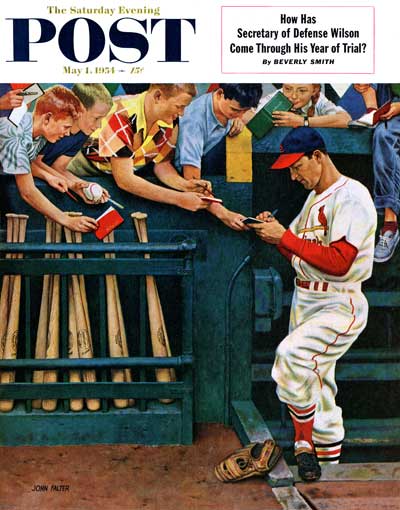
John Falter
May 1, 1954
Not only did these St. Louis kids have to miss school (awww!), they had to sit and pose with Stan the Man Musial. What a rough life. The lucky youngsters wound up with forty Musial autographs. “Wow!” one said in awe. “Will we clean up selling these at school!” We’re sure at least one of them has wished he’d kept it.
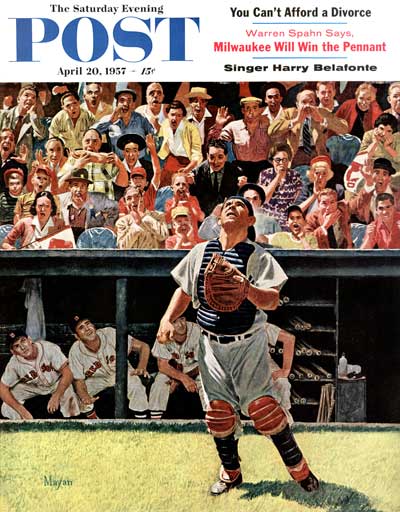
Earl Mayan
April 20, 1957
Who doesn’t love Yogi Berra? Long before he became famous for maiming the English language, Berra was catcher for the New York Yankees. Artist Earl Mayan got him to pose in Yankee Stadium for this cover. Love the fan faces! The editors informed us they were friends of the artist and “were real nice-looking people till he asked them to look like baseball fans.”
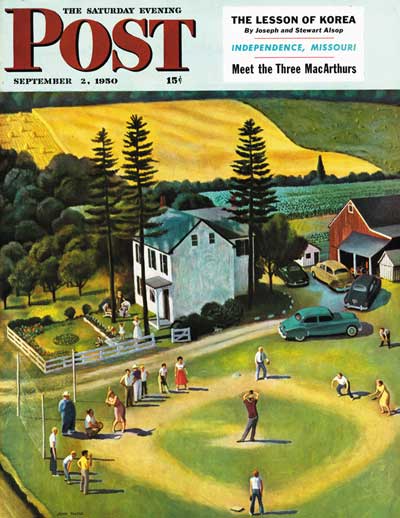
John Falter
September 2, 1950
While we admire the pros, there’s nothing like a family baseball game. It’s 1950 and Uncle Baldy can’t decide whether to pitch or throw to Aunt Sally in the yellow dress on second base and catch the guy out. We have to say Aunt Martha’s batter’s stance is interesting. The editors speculated that the umpire was selected “because he has a natural chest protector”. Well, a natural belly protector, anyway.
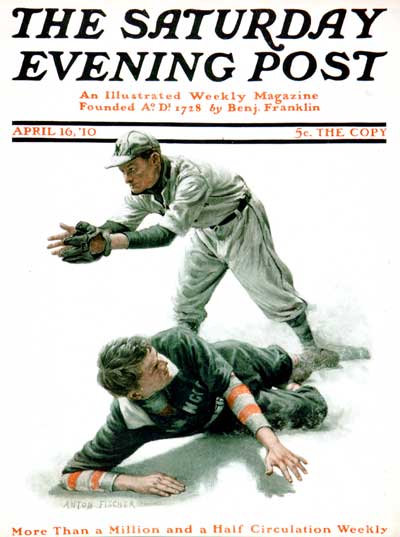
Anton Otto Fischer
April 16, 1910
It’s no surprise that they played baseball in 1910, as we see in this cover. What surprised us was the artist – none other than Anton Otto Fischer. Mostly famous for his masted ships rolling over foaming waves, Fischer also was great at painting people. This slice-of-landlubber-life captures the action perfectly. Interesting catcher’s mitt!
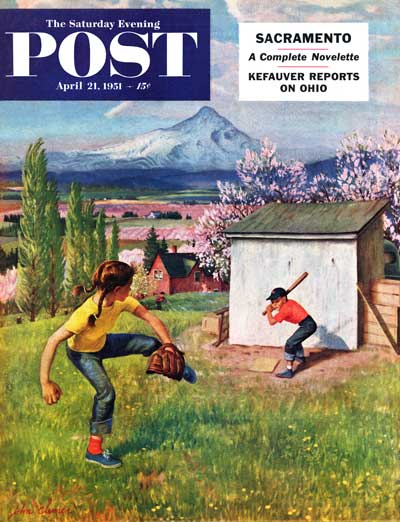
John Clymer
April 21, 1951
Artist John Clymer was known for his beautiful landscapes. Sure, he manages here to paint Oregon in all its spring glory, pink blooms, Mount Hood and all. But the eye is drawn here to the fine pitching form of Miss Pigtails and the concentration of the batter. The trees may be budding and the grass greening, but kids’ thoughts turn to baseball. It must be spring!
Descriptions by Diana Denny.
Cover Collection: Celebrating Alaska
150 years ago today, Alaska was formally transferred from Russia to the United States. The purchase of the $7.2 million was widely derided until gold was discovered 30 years later. Alaska became even more valuable during World War II as a military outpost. One hundred years after its purchase, North America’s largest oil field was discovered in Prudhoe Bay. Today, Alaska is celebrated not only for its rich natural resources, but also its rugged beauty and unique culture.
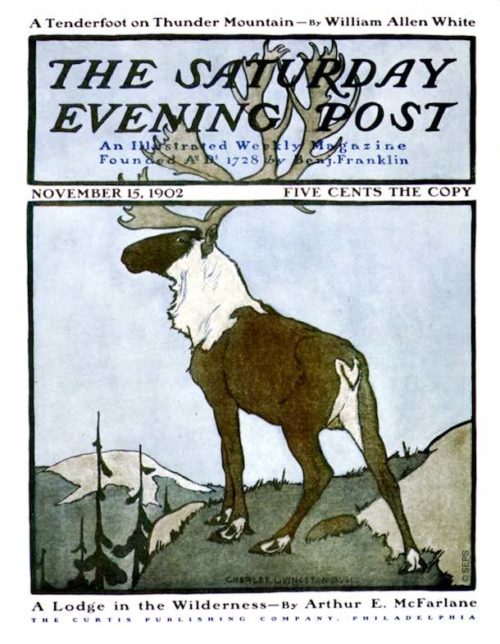
Charles Bull
November 15, 1902
Charles Bull painted many striking scenes of the Pacific Northwest, including Alaska. Despite his grand depictions of animals in nature, Bull got most of his inspiration from sketching animals at the Bronx Zoo.
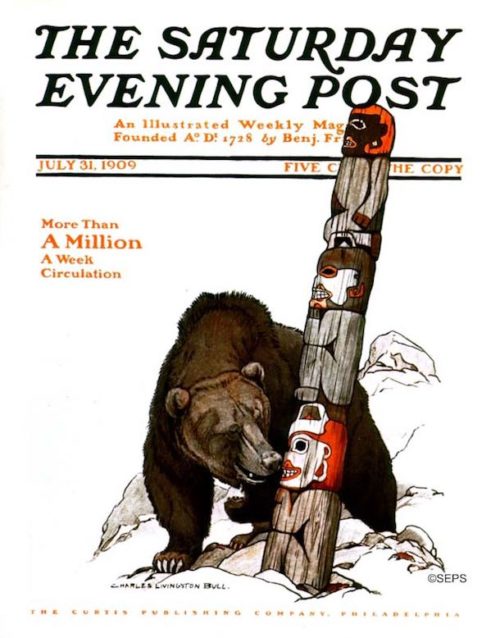
Charles Bull
July 31, 1909
The gold rush in Alaska and the Yukon territory brought many people to the area seeking their fortunes. It also piqued the interest of Americans in the the lower 48. When Charles Bull painted this cover, Alaksa was not yet even a territory; that wouldn’t happen until 1912. But Americans were likely fascinated by the region’s large animals, chilly climate, and Inuit and Yupik culture.
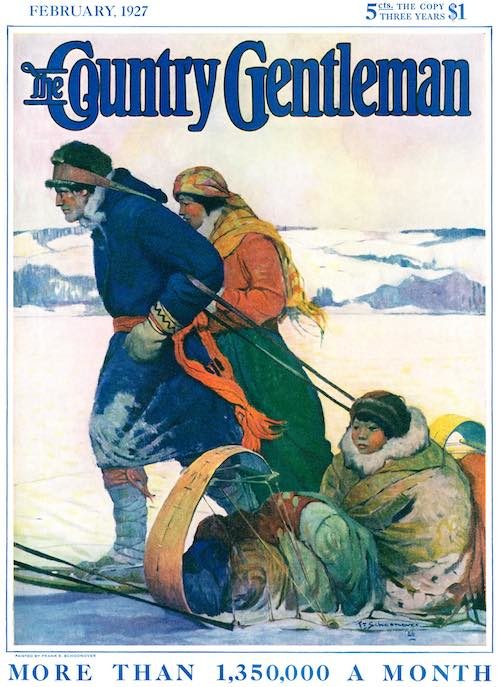
Frank E. Schoonover
February 1, 1927
Artist Frank Schoonover was part of of the Brandywine School, and studied under Howard Pyle. He painted more than 2,000 illustrations in his lifetime. This included eight covers for the Saturday Evening Post’s sister publication, Country Gentleman. Several of his covers depicted vividly colored scenes of Native Americans going about their daily lives. This cover was the first one that Schoonover painted for Country Gentleman.
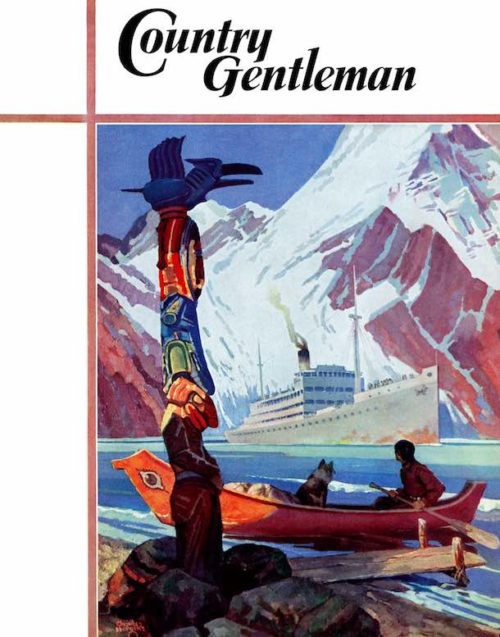
Charles Hargens
July 1, 1939
Even back in 1939, cruise ships were invading the isolated and pristine shores of Alaska. Artist Charles Hargens painted ten covers for the Post and Country Gentleman, a fraction of the more than 3,000 magazine covers he illustration. Hargens was known as a stickler for accuracy in his paintings.
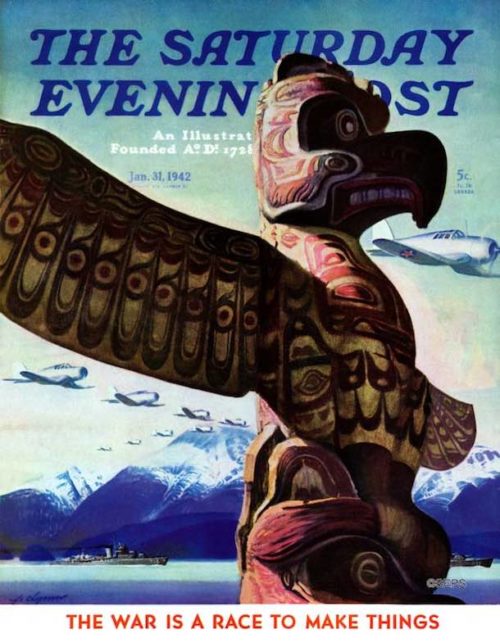
John Clymer
January 31, 1942
This cover by John Clymer illustrates the strategic importance of Alaska during World War II. Clymer painted this picture before he joined the Marines. He recalled, “I was thirty-six years old at the time, and going through boot camp with a bunch of kids nearly killed me. ¹” This was his first Post cover, but he would go on to paint 79 more.
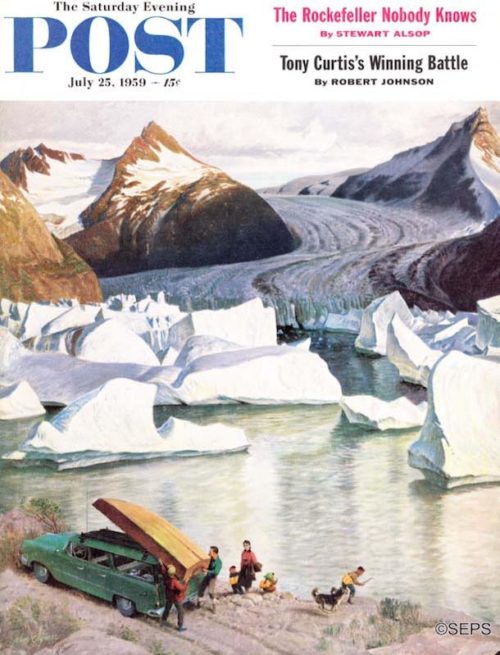
John Clymer
July 25, 1959
One overheated July day when artist John Clymer was motoring in Alaska he paused at this spot at Portage Glacier. People came and boated around beside the small bergs. Next day, when John returned to sketch, a change of wind had blown Mother Nature’s chopped ice over against the glacier, and the sketching spot was as hot as Tophet. The artist says no, he did not go over and take a ride on the glacier.
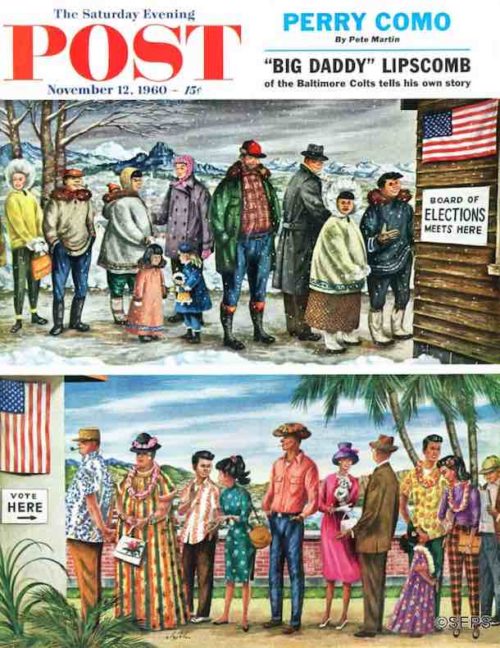
Constantin Alajalov
November 12, 1960
Alaska, along with Hawaii, were the “new” states in 1960. Cover artist Constantin Alajalov shows the citizens of each state waiting in line to vote in the 1960 presidential election (Nixon v. Kennedy—Kennedy won). Alajalov earned his voting rights the hard way. He was born in Rostov, Russia, and arrived in New York in 1923.
Cover Collection: John Clymer’s Perfect Fall Day
Artist John Clymer was a master at capturing the essence of the seasons, whether it was the delicate pink spring blooms or the bracing snap of a winter day. But autumn seemed to capture a special place in Clymer’s heart, as many of the 80 covers he painted for the Post portray this colorful season. We offer a selection of our favorites here.
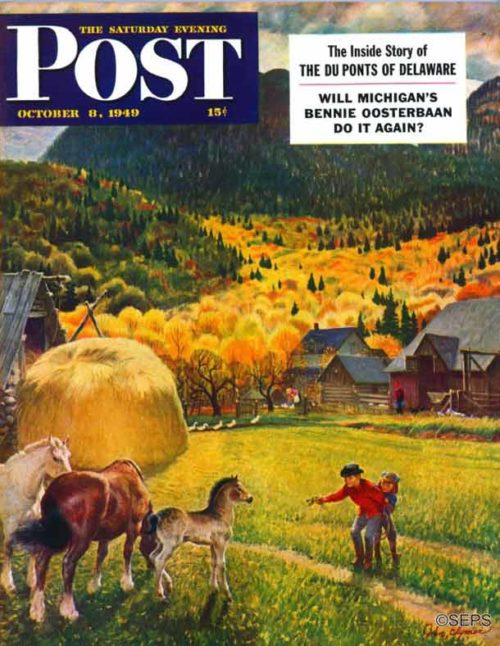
October 8, 1949
John Clymer painted this scene from his Westport, Connecticut, studio. This beautiful landscape of Washington State was recreated from memory and sketches, which he had previously made on the spot on the eastern slope of the Cascade Range. Above the town of Cle Elum the red and gold of fall climbs into the evergreen of the foothills, which in turn climb toward the big peaks where the snow comes early. Clymer believed that the little farms that snuggle cozily in the high valleys are a wonderful place to spend one’s childhood, whether one is a boy, a girl or a colt.
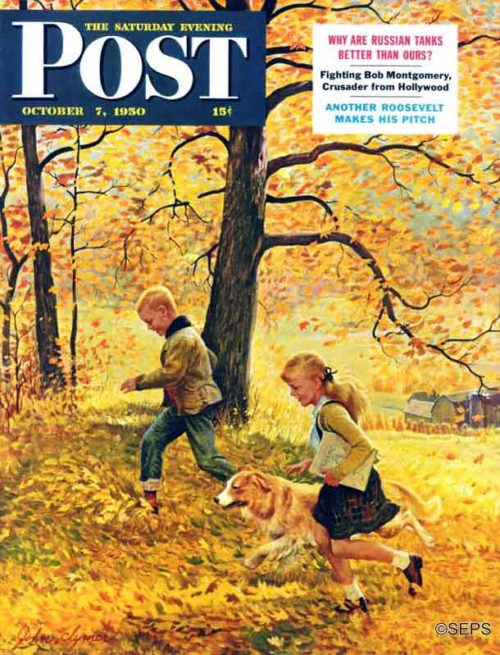
October 7, 1950
Clymer created over 80 covers for The Saturday Evening Post between 1942-1962, often portraying patriotic or western scenes. During World War II, he created illustrations for the Marine Corps magazines Leatherneck and The Marine Corps Gazette. After the war, John returned to his successful illustration business. In addition to creating charming scenes such as these two children kicking through fall leaves, Clymer also had a large stable of advertising clients including White House Scotch Whiskey, The Pennsylvania Railroad, and The Chrysler Corporation.
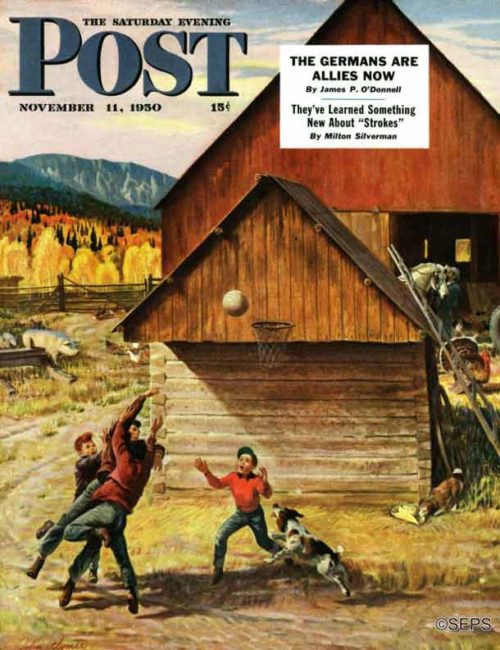
November 11, 1950
This painting will resonate with anyone who loves the movie Hoosiers, although the mountains in the background assure us that the scene is decidedly not in Indiana. Clymer was asked if one of the lads was committing a foul. He scoffed, “Certainly not. That do you want him to do, how from the waist and say, Please, may I have the ball?'”
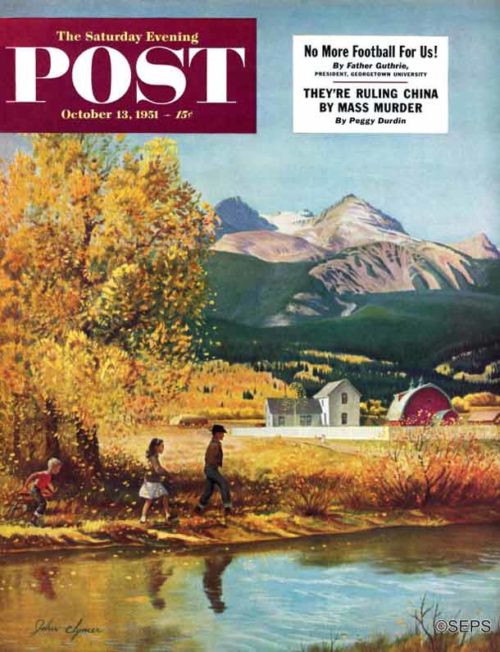
October 13, 1951
Although Clymer spent most of his adulthood in the east, he returned again and again to the landscapes of his youth. Unable to put all of America on one canvas, Clymer settled for a mountain valley in Colorado, where pines and cottonwoods waged a color battle in the foothills of the Rockies.
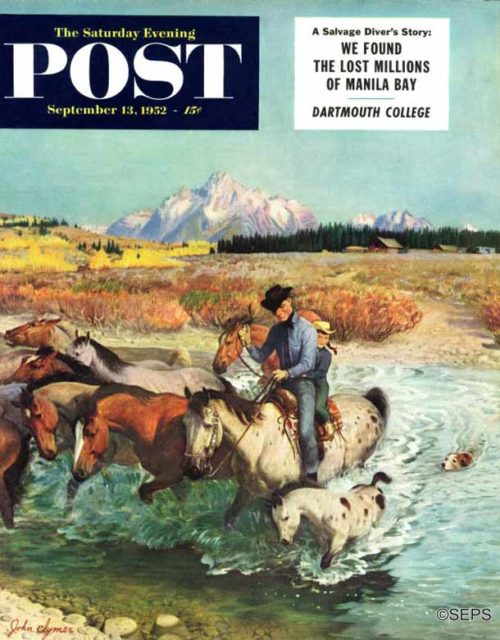
September 13, 1952
This rancher and his daughter are moving a herd of horses from one place to another in high, wide and handsome Wyoming. Note the position of the dog in the water. Clymer first painted that dog far back on the trail, then moved him up near the creek, then drew him splashing into the water, then put him where he is now and hurriedly sent the painting to the Post before he could change his mind again.
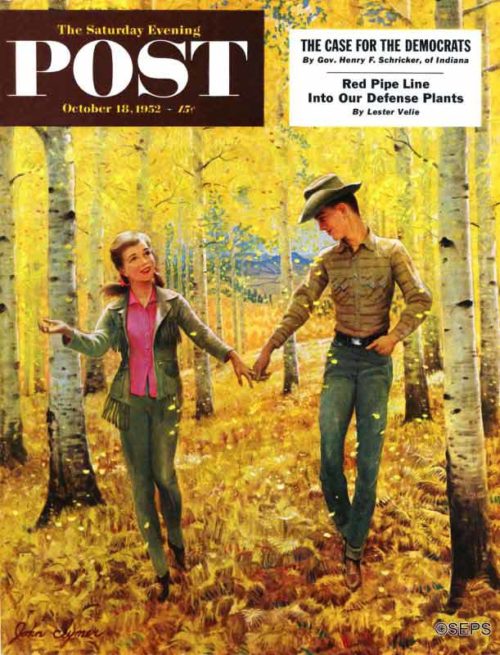
October 18, 1952
Until a traveling magazine salesman sold the Clymer family several magazine subscriptions, the artist did not have an inkling what his future might hold. Enamored by the work of Walt Louderback that he saw within these publications, Clymer chose his profession. He said, “When I got into my early teens, like all boys, I got to wondering what in the world could I do to make a living and live in the mountains? One day I got to thinking about it and thought, that’s it! I’ll paint pictures and then I can live wherever I want to live.”
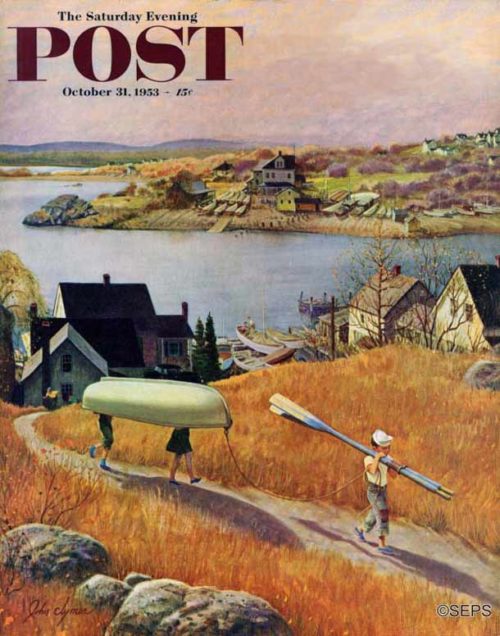
October 31, 1953
Throughout the 1950s and into the 1960s, Clymer’s Post covers carried themes that were simple and pleasurable: a picnic lunch, a nature hike, or an afternoon ride through the apple orchard. In all cases, the figures seem dwarfed by the majesty of the American West. His characters reflect a childlike wonder at the enormity of nature. The beauty of his approach is in his ability to transcend a specific place in time.
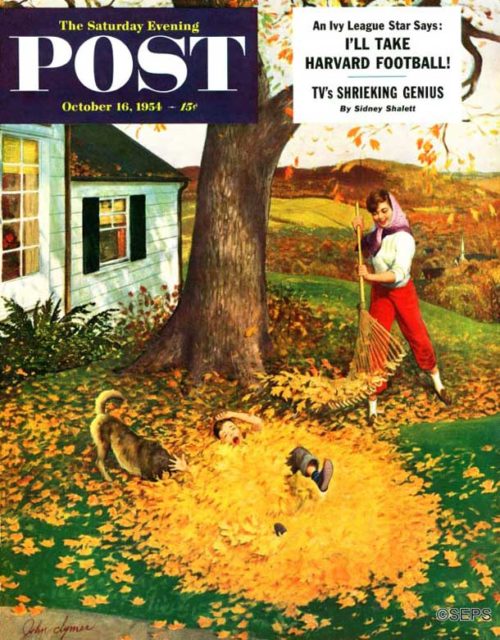
October 16, 1954
When writing the description to accompany this cover, the editors of the 1954 Post asked, “how long will it be before somebody invents a suburban-lawn-type, motorized, leaf- raking combine, equipped with semiautomatic steering wheel, chaise longue for the operator, soft-drink-vending machine, radio, foot warmer and convertible top, to sell for $99.98?” We’re happy to report that, in 2017, such a device can be purchased (minus the soft drink machine), but it will cost you a little more than $99.98.
Cover Gallery: Salute to the 50 States
From the lighthouses of Maine to the majestic Cascades of Oregon, The Saturday Evening Post has represented every state on its cover. Here are 50 of our favorites.
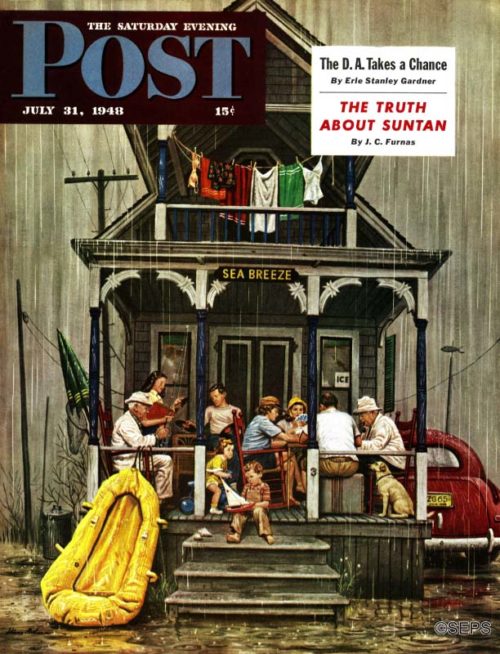
Rainy Day at the Beach
Stevan Dohanos
July 31, 1948
This lonely, wet house surrounded by raindrops and telephone poles would fit right in at Ft. Morgan Beach, Alabama, the narrowest strip of land with nothing but sand, sea grass, and a handful of houses.
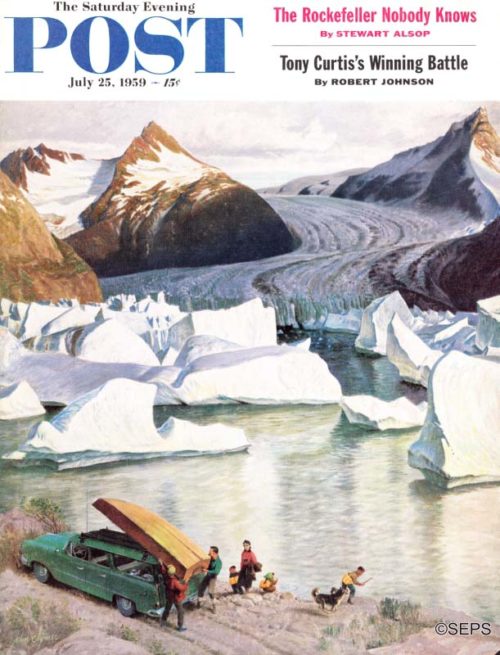
Portage Glacier
John Falter
July 25, 1959
One overheated July day when artist John Clymer was motoring in Alaska he paused at this spot at Portage Glacier. People came and boated around beside the small bergs. Next day, when John returned to sketch, a change of wind had blown Mother Nature’s chopped ice over against the glacier, and the sketching spot was as hot as Tophet. The artist says no, he did not go over and take a ride on the glacier.
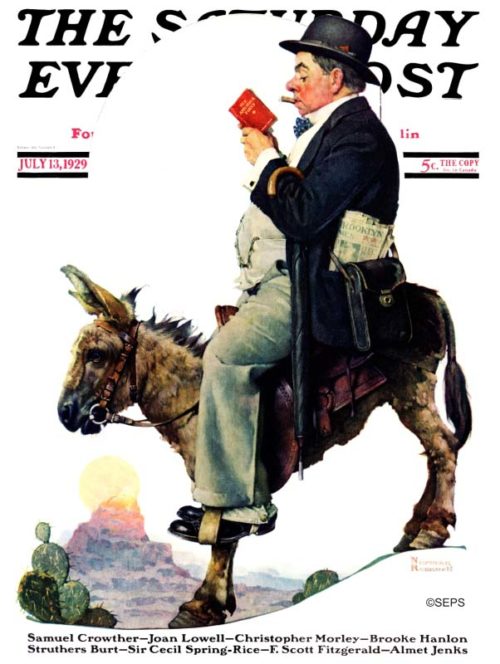
Prospector
Norman Rockwell
July 13, 1929
Rockwell portrayed many forms of transportation in his Saturday Evening Post covers. People traveled by car, train, boat, airplane, soapbox, and stilts, but there was only one way to observe the mountainous terrain of the West successfully – on the back of a mule. When Rockwell traveled through the West, he preferred to tickle his audience with human-sized details, rather than its awesome magnificence.
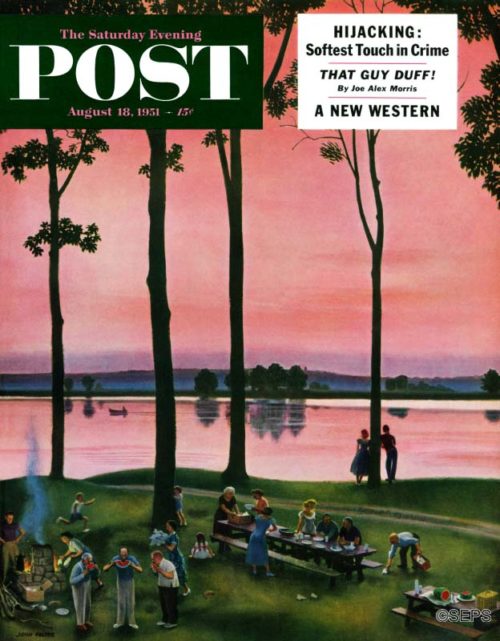
Evening Picnic
John Falter
August 18, 1951
Sometimes Nature rains on a picnic; sometimes she is just neutral; and sometimes, as in this mood caught by John Falter’s brush, she glories in the occasion herself, painting a magic sunset, smoothing the waterways into mirrors, tempering the temperature, even arranging for watermelons to be at their most luscious ripeness.
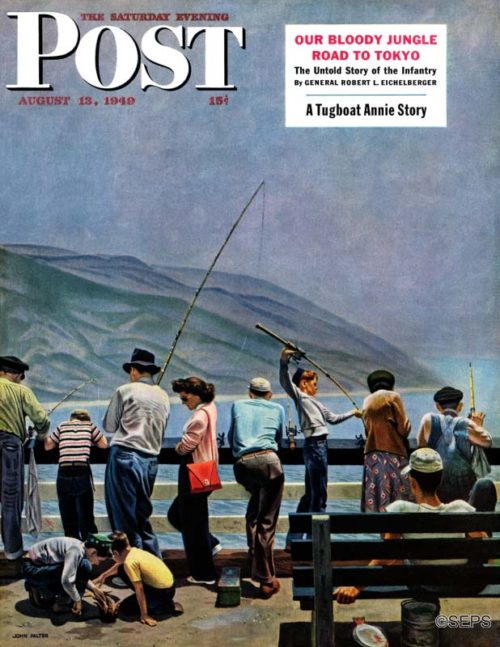
Santa Monica Pier Fishing
John Falter
August 13, 1949
On the long fishing pier at Santa Monica, California, tourists from all over the United States stand packed together like sardines while they try to catch fish. Many of the fishermen go through their routine calmly and expertly; occasionally a greenhorn flies into a tizzy, yelps for the landing net and hauls in a dwarf flounder or something else depressing. Artist John Falter was non-committal about whether he caught anything—besides a Post cover.
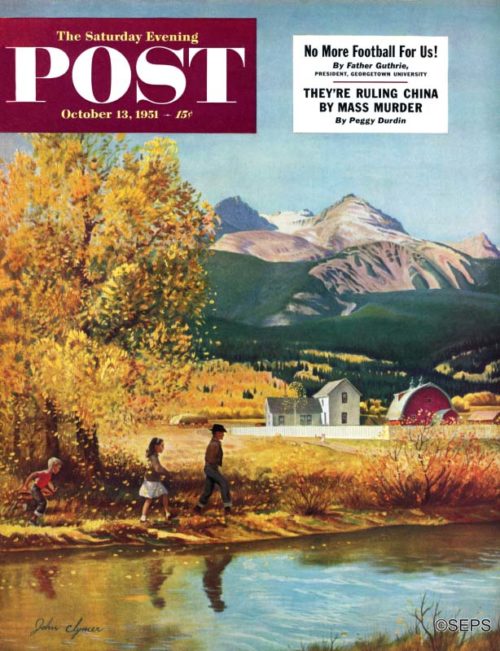
Colorado Creek
John Clymer
October 13, 1951
John Clymer, unable to put all of America on one canvas, settles for a mountain valley in Colorado, where pines and cottonwoods are waging a color battle in the foothills of the Rockies, while up beyond the timber line the slanting sun rays play a red-and-violet game of tag.
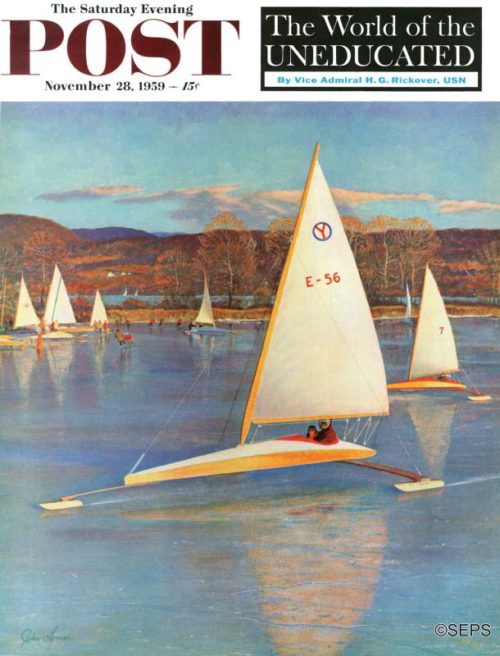
Sailboats
John Clymer
November 28, 1959
Hollanders started putting runners on boats circa 1750. Early United States ice- boaters appeared on the Hudson, where they raced New York Central trains. In 1959, ice-yacht clubs were likely to spring up wherever it didn’t snow too much but where water turned hard in winter. The original caption from 1959 claims this to be Lake Warren, Connecticut, but modern searching could find no such lake. Perhaps it’s Lake Waramaug, near the town of Warren.
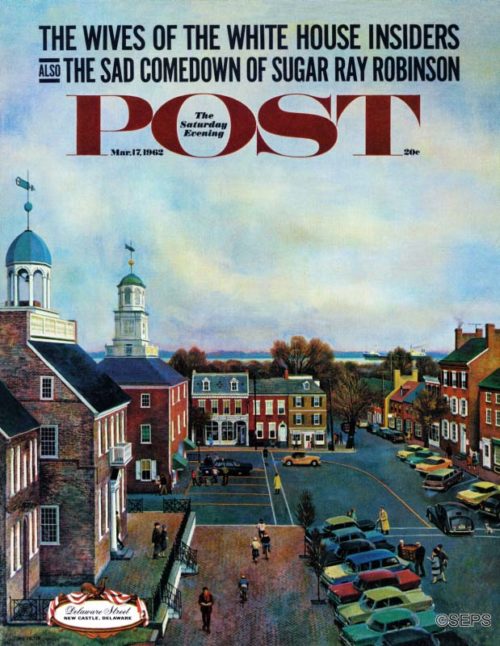
Town Square, New Castle, Delaware
March 17, 1962
New Castle, on the busy Delaware River, is six miles south of the state’s largest city, Wilmington, and two miles off the main highway. Once it was Delaware’s capital. Founded in 1651, it was William Penn’s landing place when he came to America in 1682. Penn is thought to have spent a night in the house at the extreme right of our cover. The spire atop the Court House (left foreground) was used as the center of a twelve-mile radius in part of the 1763-67 survey—to settle a boundary dispute—that resulted in the Mason-Dixon Line, which later played a key part in United States history.
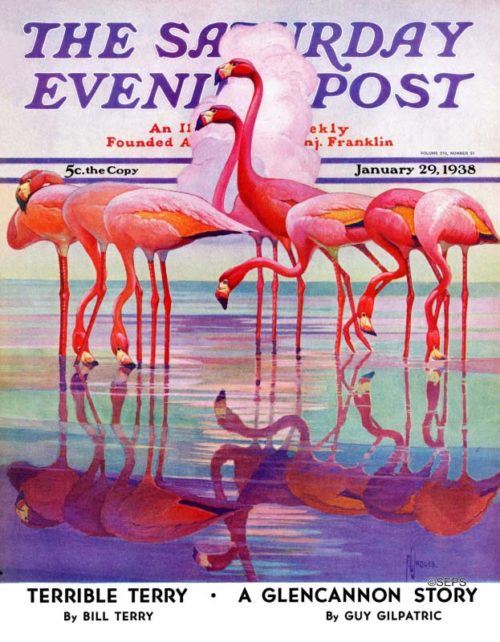
Pink Flamingos
Francis Lee Jacques
January 29, 1938
In the early 1800s, Florida was home to hundreds of thousands of Flamingos. By the turn of the century, the wild birds were all but gone from the state, eradicated by egg and feather collectors. In recent years, the birds seem to be making a slow comeback in the Everglades, a vast improvement over the plastic, front-lawn variety.
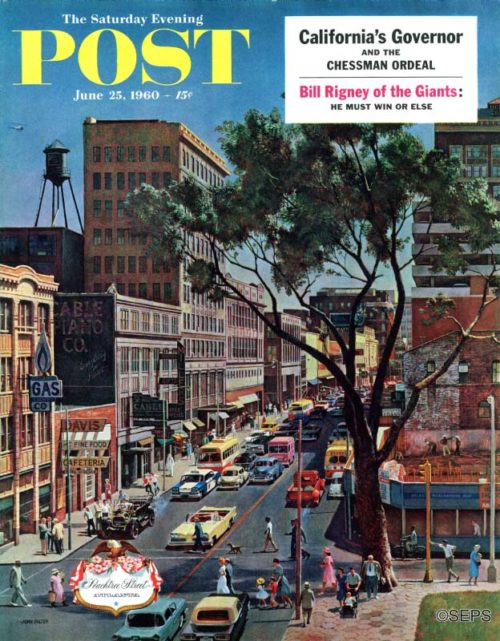
Peachtree Street, Atlanta
John Falter
June 25, 1960
John Falter depicted Peachtree Street at the Harris Street intersection, looking south toward Five Points. The gentleman on crutches at lower left is Ernest Rogers, who was an Atlanta Journal columnist and the popular “Mayor of Peachtree Street.”
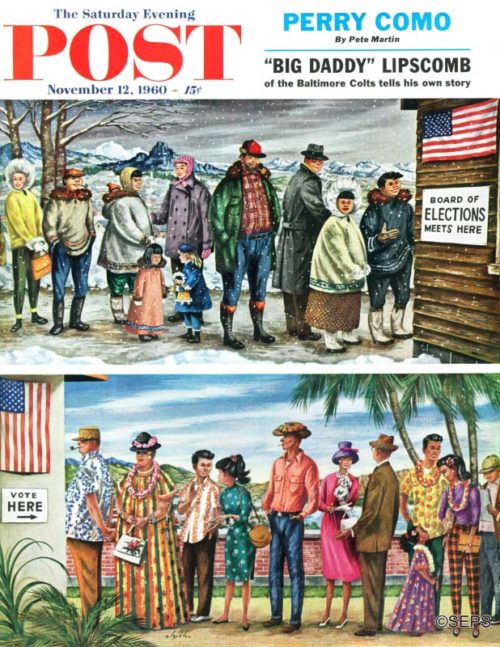
First Vote in the New States
Constantin Alajalov
November 12, 1960
We couldn’t find a cover dedicated solely to Hawaii; here it must share billing with Alaska, the other “new” state in 1960. Cover artist Constantin Alajalov shows the citizens of each state waiting in line to vote in the 1960 presidential election (Nixon v. Kennedy—Kennedy won). Alajalov earned his voting rights the hard way. He was born in Rostov, Russia, and arrived in New York in 1923. Naturalized citizen Alajalov has produced a lighthearted scene, but his underlying message gives us pause: This amalgam of people living together in harmony is bright evidence of the democratic way of life they’re voting to preserve.
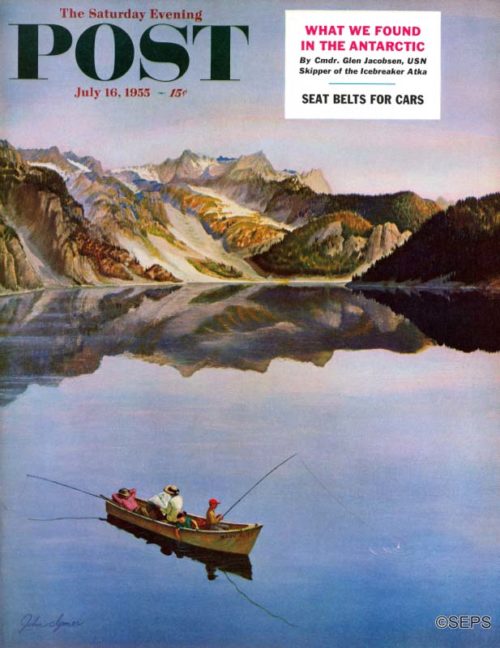
Fishing on a Mountain Lake
John Clymer
July 16, 1955
In America’s Western skylands are many jewel lakes, set in the gold and silver of clasping peaks. This looks to be in the vicinity of Sawtooth National Forest, but which mountain lake is anybody’s guess.
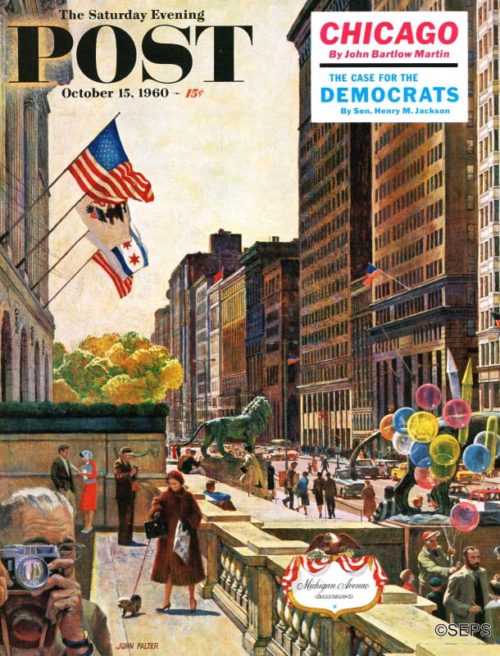
Michigan Avenue, Chicago
John Falter
October 15, 1960
The standard picture-post-card view of Chicago is of Michigan Avenue, looking north toward the Tribune Tower and Wrigley Building. Artist John Falter gives us instead a southern exposure of this elegant avenue—with the Wrigley Building and environs reflected in the camera lens at left. Behind the lofty buildings on the right is the Loop; facing them are the Art Institute, set in Grant Park, and Lake Michigan. The whiskered gent with sketch pad is the late Louis Sullivan, Frank Lloyd Wright’s mentor and an architect who helped reshape the face of this frisky city. (Sullivan had an office in Orchestra Hall, the second building from right.) We thought we had spotted another eminent Chicagoan, Al Capone, in the foreground. But Falter assures us we’re imagining things.
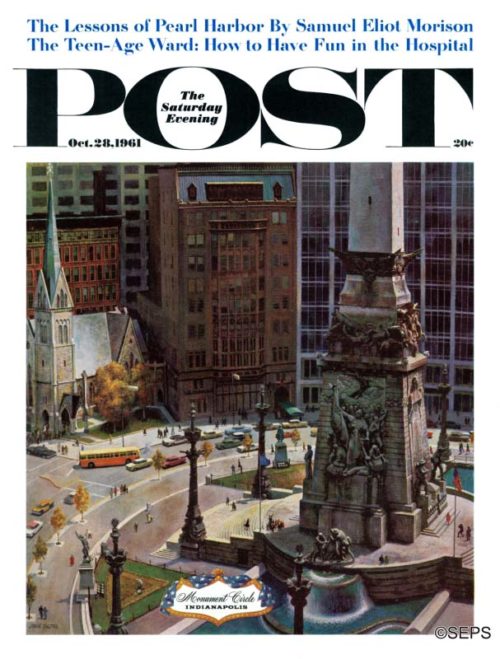
Monument Circle
John Falter
October 28, 1961
Monument Circle takes its name from the limestone memorial to soldiers and sailors at its center. And the circle is at the very center of Indianapolis, which is right in the middle of the Hoosier state. Artist John Falter discerned a faintly French flavor in this scene — perhaps because Indianapolis was planned on the pattern of Washington, D.C., which was laid out by a Frenchman. But consider the English Gothic architecture of Christ Church Cathedral at the left, the vaguely Tudor air of the neighboring Columbia Club, and the bluntly modern design of the Fidelity Building. French, English, or just plain American, the circle suits a city with a half-Greek name.
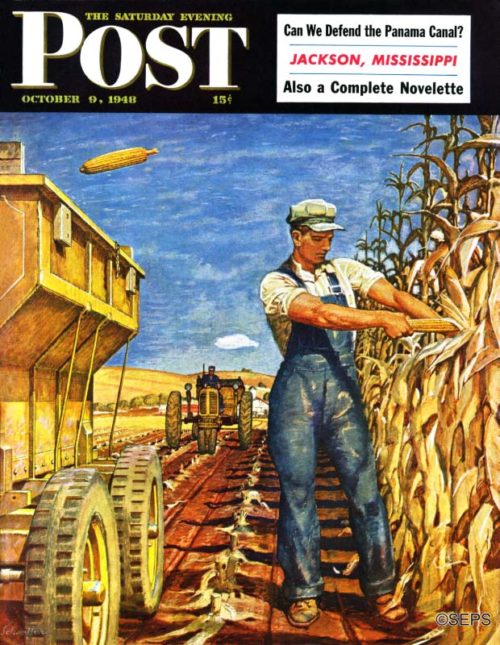
Corn Harvest
Mead Schaeffer
October 9, 1948
This Mead Schaeffer cover shows corn being picked by the “bang-board” method, which allowed a man to throw ears into the wagon without looking, because they would bang against a high board at the far side of the wagon and drop in. By 1948, most big farms used mechanical corn pickers, including the Lawton, Iowa, farm of Louis Peterson, the setting of this picture. The mechanical picker had already been used on much of the field, as the rows of stubble indicate, but the day Schaeffer was there, the machine was busy elsewhere. Farmer Peterson needed a little corn for his hogs. He got it the bang-board way—and Schaeffer got this cover.
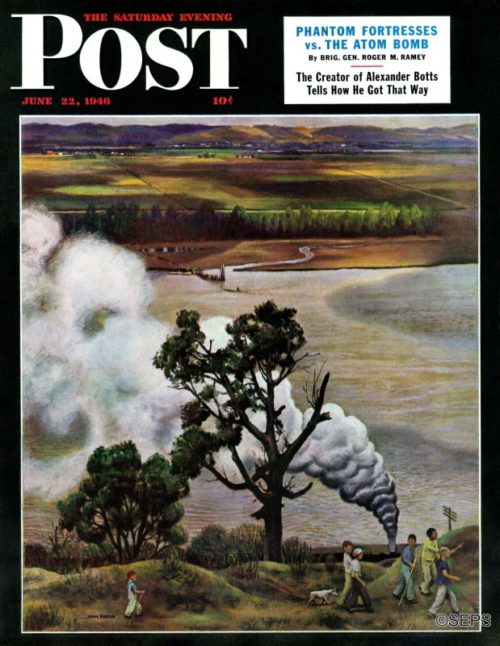
Steam Engine Along the Missouri
John Falter
June 22, 1946
You are looking across one of the great rivers of America—the Missouri. You are in Kansas, gazing across into Missouri. The town in the distance is Armour Junction. Those flat fields across the way are likely to disappear when the Missouri gets one of its expansive moods. John Falter painted the scene when he visited a farm his father had just bought—painted it, in fact, from a bedroom window in the farmhouse. He had paints and brushes, but no canvas, so painted this one over an old picture that came with the house. The tagalong lad bringing up the rear of the little expedition—Lewis and Clark used the same route—is Falter’s nephew.
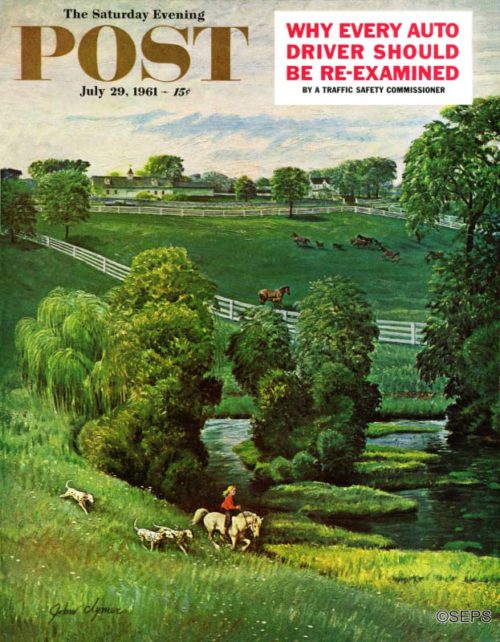
Green Kentucky Pastures
John Clymer
July 29, 1961
Our cover is a composite of scenes observed by artist John Clymer near Lexington. There may be gold—a future Derby winner, that is—among the foals behind the fences of that paddock. But none of the foals seems in a hurry to be over the fence and romping with Goldilocks and her three Dalmatians or thundering down the homestretch at Churchill Downs. Perhaps the reason is that the grass down here doesn’t always seem greener on the other side. This is Bluegrass country.
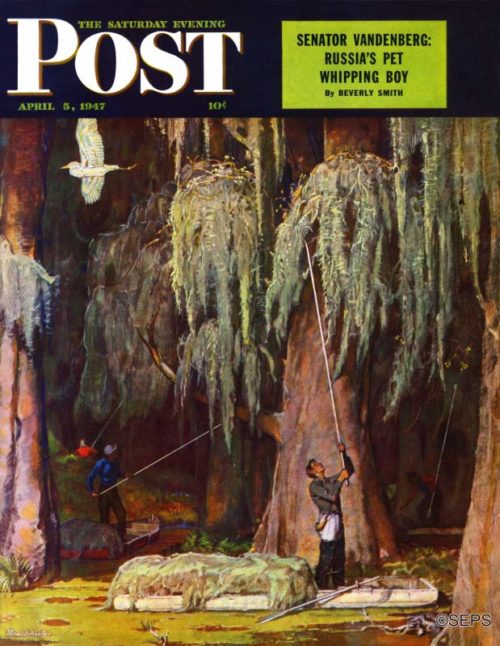
Spanish Moss Pickers
Mead Schaeffer
April 5, 1947
Artist Mead Schaeffer contributes another to our series of regional covers with a scene he sketched south of New Orleans, in the bayou country. Near Lafitte, Louisiana, he watched a harvest distinctive to the South. Moss pickers were hauling down boatloads of the beautiful Spanish moss that festoons trees in the South; the moss was dried and used in upholstering.
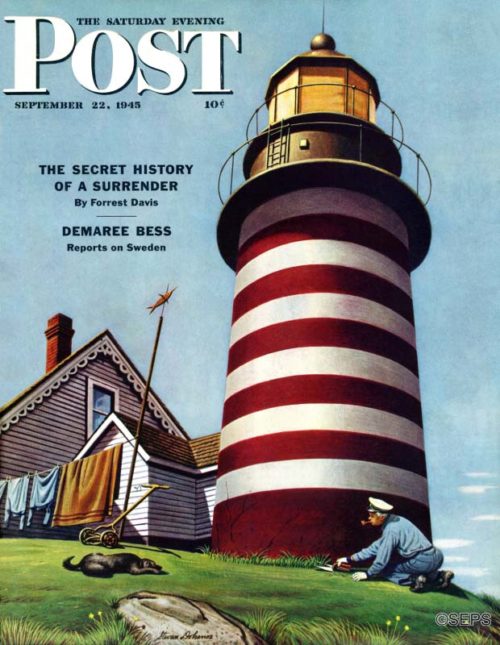
Lighthouse Keeper
Stevan Dohanos
September 22, 1945
The lighthouse on the cover is the West Quoddy Light, Lubec, Maine, but the lighthouse keeper is pruning the grass at Sankaty Light, Nantucket, a neat trick that can happen only in the world of art. What happened was that artist Stevan Dohanos made his preliminary sketches of the West Quoddy Light the summer before. The next year, to freshen his memory on lighthouse detail, he journeyed up to the Sankaty Light. It turned out the Sankaty Light had “a very strong personality of its own,” and wasn’t much good as a source of information on the situation in West Quoddy. However, they were cutting the grass at Sankaty Light, and Dohanos liked that touch of domesticity, so he included it.
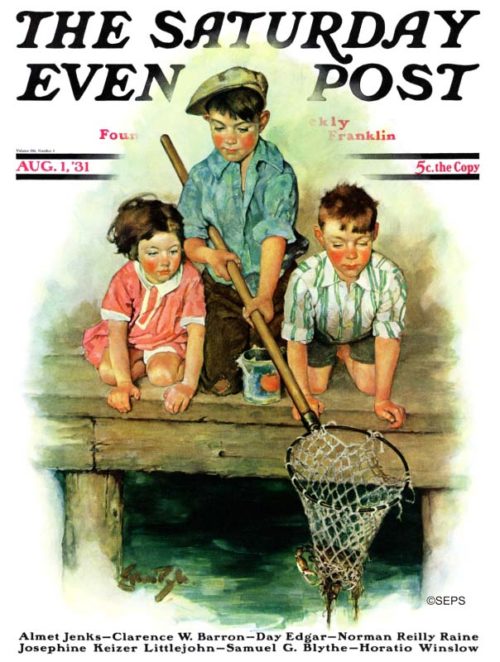
Crabbing
Ellen Pyle
August 1, 1931
The Chesapeake Bay makes a great location for crabbing, with more than 7,000 miles of shoreline and plenty of piers to dip your net. Any good Marylander knows what to do with that fat crab, but these kids don’t look so sure.
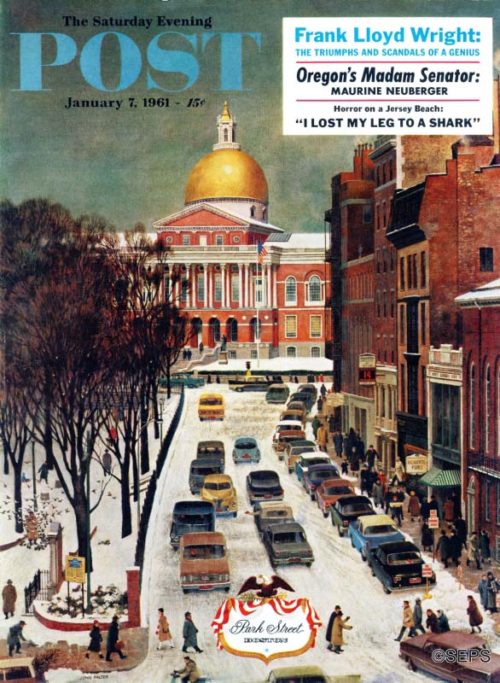
Park Street, Boston
January 7, 1961
Welcome to historic Park Street circa 1961, looking north toward the gold-domed State House. To the left, Boston Common; to the right, the Old Granary Burial Ground, where lie Paul Revere, John Hancock and Samuel Adams. That’s Park Street Church in the foreground; its site is known as “Brimstone Corner.” The yule tree being carted off at lower left indicates that Christmas no longer is banned in Boston, as it was when the Puritans held sway. As for the 1913 Pierce Arrow approaching from the right, artist John Falter tells us it originally belonged to Boston astronomer Percival Lowell, brother of poet Amy Lowell.
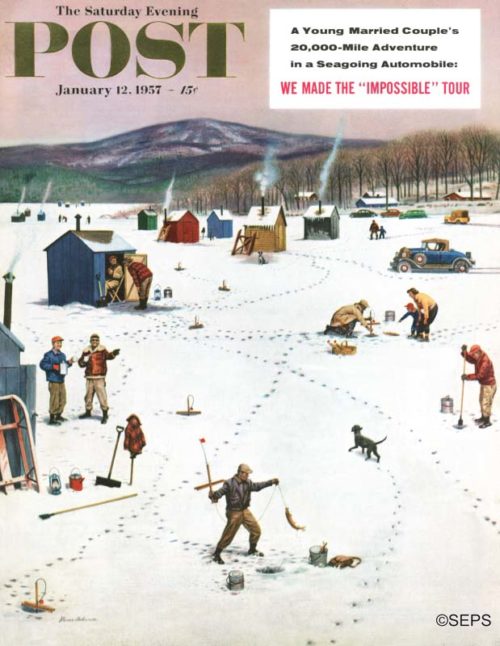
Ice Fishing Camp
Stevan Dohanos
January 12, 1957
These shacks, which sit over fishing holes on the ice, are as cozy as living rooms, though less roomy, and they smell deliciously of coffee with occasional whiffs of kerosene.
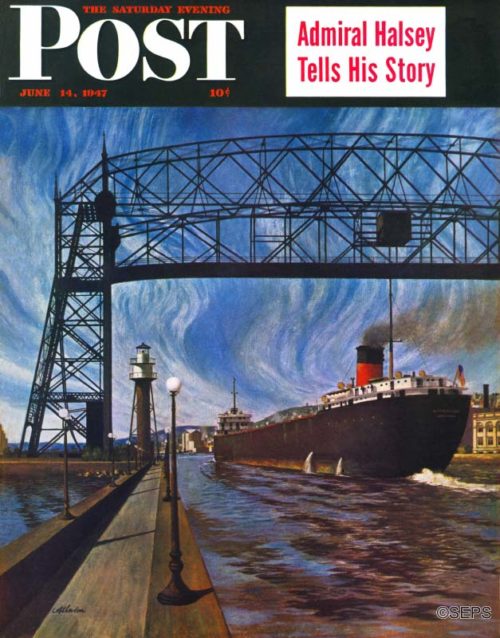
Ore Barge
John Atherton
June 14, 1947
John Atherton’s cover painting is a view of the husky city of Duluth. This is the ship canal through which ore boats moved out to begin their travels in the Great Lakes. The ore came from the great Mesabi Range. Atherton chose a moment when the bridge had lifted to let one of the ore boats pass below.
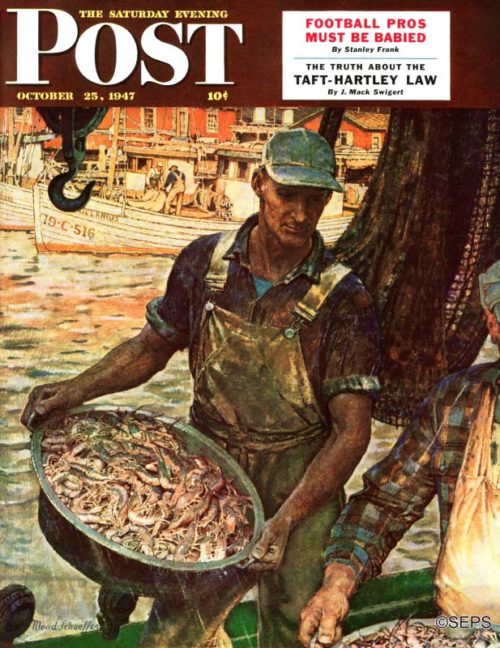
Shrimpers
Mead Schaeffer
October 25, 1947
Mead Schaeffer turned south to Biloxi and its shrimp-fishing fleet. As one who sees shrimp most often in a cocktail, served pretty sparingly, the artist was slightly staggered by the size of the fleet and the volume in which they bring shrimp to the packing houses.
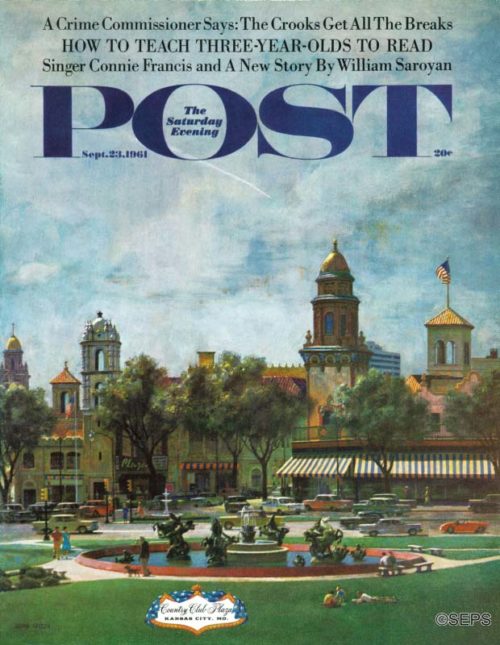
Kansas City
John Falter
September 23, 1961
Spanish architecture in Missouri? If such a state of affairs seems peculiar, consider that the unpredictable Show Me state even has a town named Peculiar (pop. 458), some twenty miles south of here, on U.S. 71. Our cover scene is in Kansas City, “the gateway to the Southwest,” and you are looking at the intersection where U.S. 50, gateway to the Country Club Plaza shopping center, crosses J. C. Nichols Parkway. This elegant community of shops was conceived and built by Jesse Clyde Nichols (1880-1950), to whom the fountain in the foreground is a memorial. The scene appealed to artist John Falter because the Old World architecture seemed to symbolize our nation’s roots — which is not to deny the notion expressed by lyricist Oscar Hammerstein in Oklahoma! that “everything’s up-to-date in Kansas City.”
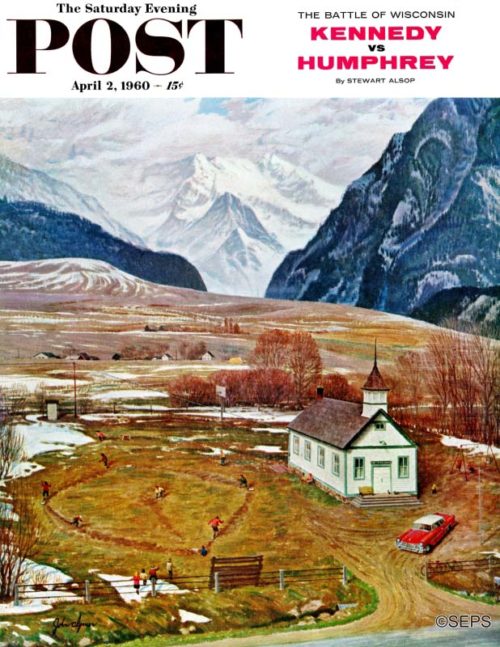
Recess at Pine Creek
John Clymer
April 2, 1960
It’s recess time in Pine Creek, Montana. Artist John Clymer had often passed this one-room schoolhouse en route to nearby Yellowstone National Park, thinking each time that it belonged on the cover of the Post. Clymer confesses that in order to get the part of the Absaroka Mountains on the canvas, he had to turn the schoolyard around.
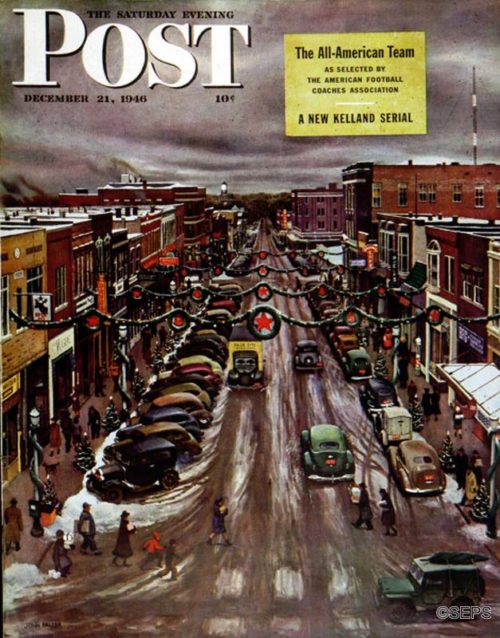
Falls City, Nebraska
John Falter
December 21, 1946
As a setting for his picture of the last-minute Christmas rush, John Falter chose the town where he spent his boyhood: Falls City, Nebraska. The finished job is a mixture of paint and recollection. That water tower in the distance, for example, was a favored roost for Falls City boys on hot summer nights. They liked to sleep there. City authorities met in some alarm — the surrounding platform is seventy-five feet above ground — and forbade it. Falter had no trouble recalling the Christmas rush. As a boy, he worked in his father’s clothing store on this street. A good many customers bought new outfits for the holidays, and young Falter was the pants runner — he ran trousers from the store to the tailor’s, to get them shortened. Only customers appear in this painting. But the artist’s sympathies doubtless are with those on the selling side of the counter.
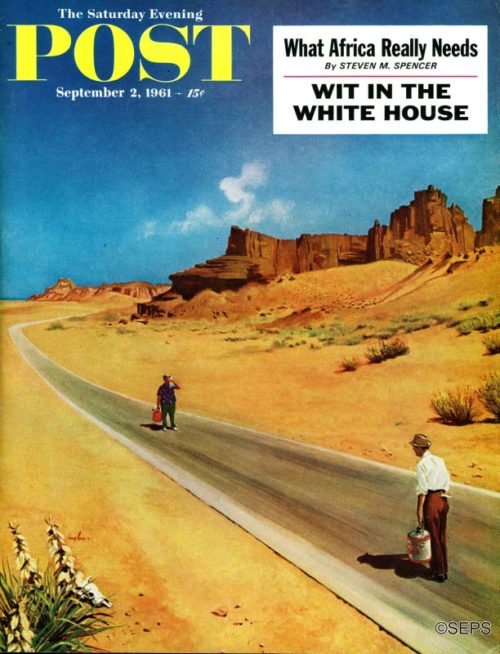
Out of Gas
George Hughes
September 2, 1961
The setting of this depressing encounter is not fifty miles from nowhere. This is nowhere. Artist George Hughes pieced together the landscape from some of the more desolate terrain of the Southwest, where the skies are not cloudy all day and where seldom is heard a discouraging word. Both pedestrians on our cover have, however, been subjected to some rather discouraging words: Exactly 2.6 miles in either direction is a fuelless automobile, and in each automobile sits a wife who was ignored earlier in the day when she suggested, “Don’t you think we’d better stop? The sign at that station says, Last Gas for 40 Miles.” And you should have heard the discouraging mutterings when these chastised males discovered that their spare-gas cans were drier than a sun-baked skull.
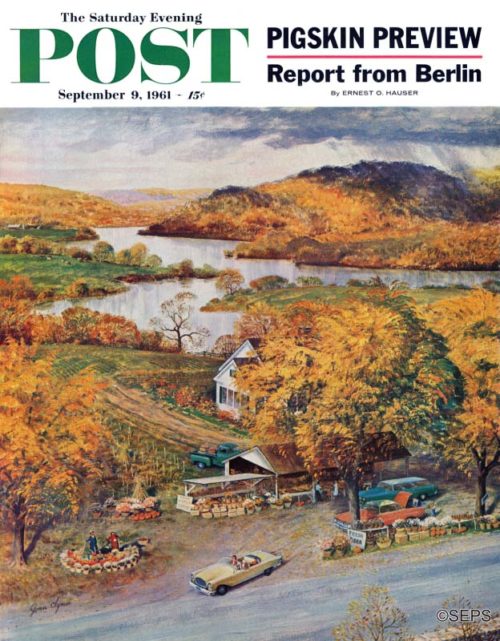
Roadside Vegetable Stand
John Clymer
September 9, 1961
What is more inspiring than the New England countryside in the fall? Indeed, the autumnal delicacies on sale in the foreground of John Clymer’s pumpkin-colored scene inspired us to turn to our bookshelf, where we found Henry David Thoreau saying, “I would rather sit on a pumpkin, and have it all to myself, than to be crowded on a velvet cushion.” (Although there’s no denying that pumpkins are more advantageously used in pies, soups and puddings.)
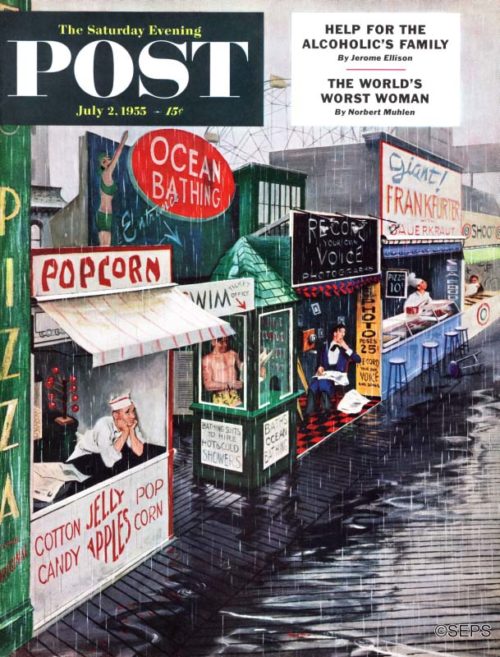
Rain on the Boardwalk
George Hughes
July 2, 1955
True, these poor fellows on Mr. Hughes’ boardwalk are heart-rending, also 5,000 souls sardined into nearby cottages, but as oceans are useless without water, can’t everybody resolve to observe this as Be Kind to Rain Week?
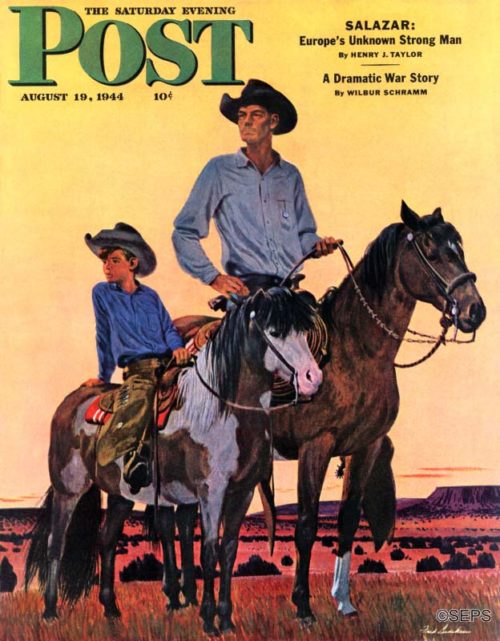
Surveying the Ranch
Fred Ludekens
August 19, 1944
Although Fred Ludekens lived most of his life in California, this scene has a distinctly New Mexican flavor. Ludekens never worked from photos and didn’t use models. Not one to limit himself to just one subject, Ludekens also painted interior images to accompany a Robert Heinlein story about interplanetary travel, which also appeared in the Post.
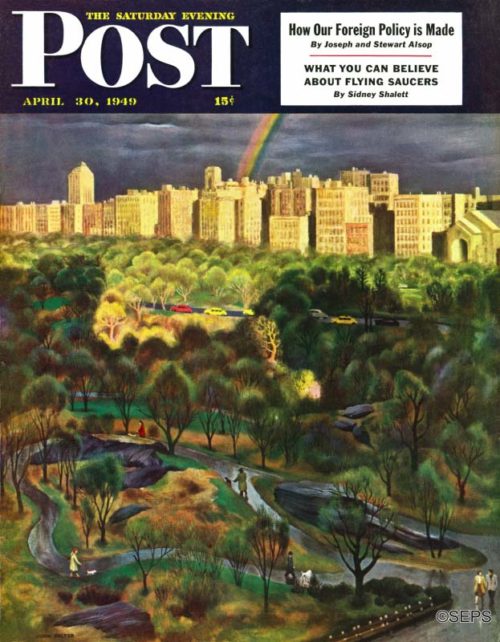
Central Park Rainbow
John Falter
April 30, 1949
When John Falter’s cover painting was accepted, there was lightning trickling down the sky beside the rainbow. Presently the Art Department began to worry—do lightning and rainbows ever show up at the same time? The ever helpful Weather Bureau was asked to look at the Post‘s storm—which has just doused midtown New York and is rumbling away beyond Central Park’s man-made ramparts. “Fair and cooler,” was the comment. “But we never saw a streak of lightning in such bright daylight. Of course, where weather is concerned, anything can happen.” So the picture was delightninged, leaving only that sign of clearing weather, a patch of blue sky large enough to make a sailor a pair of breeches.
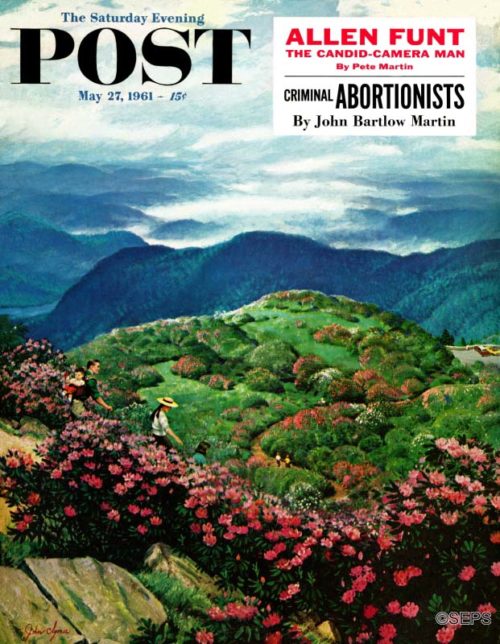
Appalachian Rhododendrons
John Clymer
May 27, 1961
Catawba rhododendron thrives in many sections of the southern Appalachians, but rarely is it so brilliantly beautiful as here at Craggy Gardens, along the Blue Ridge Parkway near Asheville, North Carolina. Our scene shows the trail to Craggy Pinnacle. “Sections of the trail wind through ten-foot-high rhododendrons,” artist John Clymer said. “And the ground is carpeted with the rich-pink petals of the flowers that have fallen.” Clymer’s painting is a preview of a coming attraction: These floriferous slopes look their best in mid-June, as they did in the days when the Catawba and the Cherokee held sway in the Carolinas.
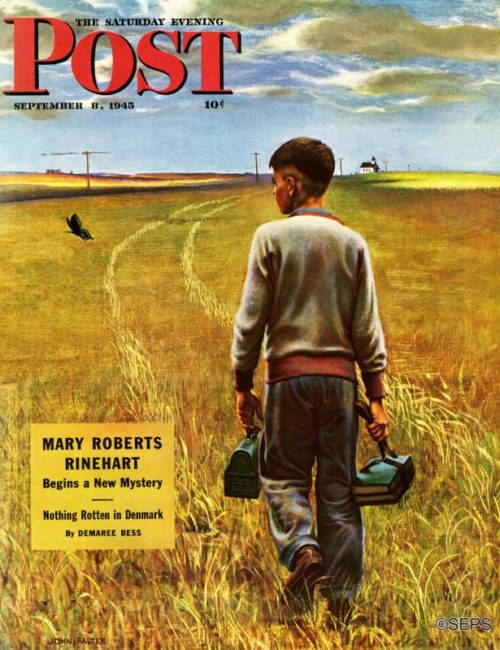
Amber Waves of Grain
John Falter
September 8, 1945
John Falter’s ” back-to-school ” cover shows a lad with a new haircut crossing the fields to a country schoolhouse. This is one that we’re not 100% sure is in North Dakota, but the scene landscape looks decidedly North Dakotan. If you’re from the state, let us know if you disagree.
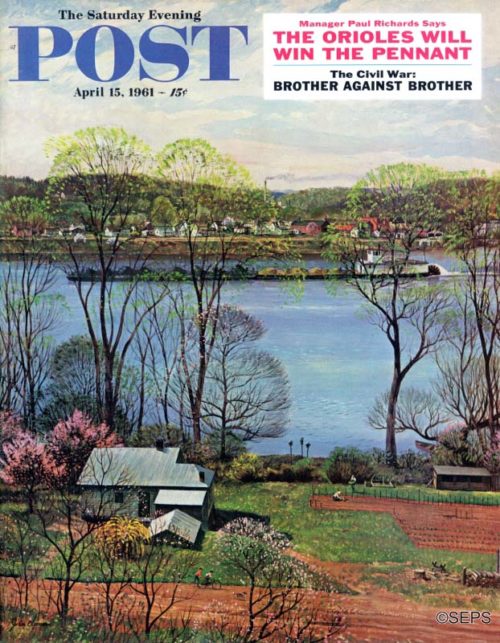
Ohio River in April
John Clymer
April 15, 1961
Heading down the Ohio is a venerable stern-wheeler, push-towing barges loaded with coal and gravel. Cargo by the tens of millions of tons is shipped up and down the Ohio in this manner each year, between Pittsburgh, at the confluence of the Allegheny and Monongahela, and Cairo, Illinois, where the Ohio empties into the Mississippi. (The watershed of the Ohio reaches into fourteen states.) Artist John Clymer formed his riverscape by piecing together the water’s-edge scenes that appealed to him most. The near shore is West Virginia; the far shore is Ohio.
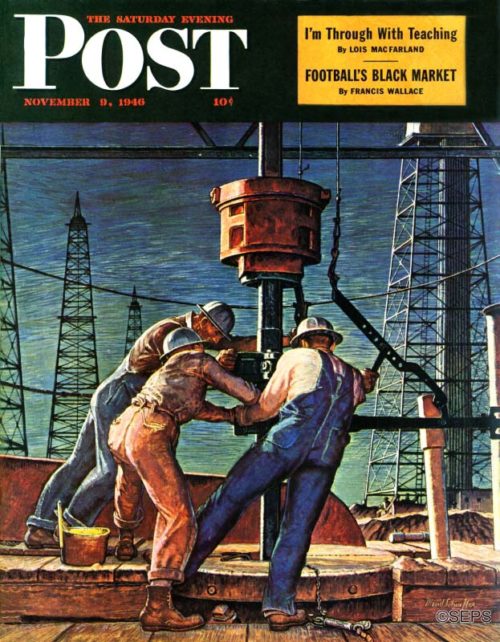
Drilling for Oil
Mead Schaeffer
November 9, 1946
Artist Mead Schaeffer and his wife worked near Oklahoma City, Oklahoma, for Schaeffer’s oil country cover—if you can call it ” working.” Had they come to town on a vacation, they couldn’t have had more of a social whirl. Their plane arrived just before sunrise and, much to the Schaeffers’ surprise, the fire chief’s red car was waiting. So was the mayor, who read a proclamation declaring them welcome and offered a key to the city. The Schaeffers found every minute they could spare had been booked for social engagements, and this was true throughout their stay. It was by all odds the warmest reception the Schaeffers have met in their travels working on Post covers, and they went away as impressed with Oklahoma courtesy as with Oklahoma oil.
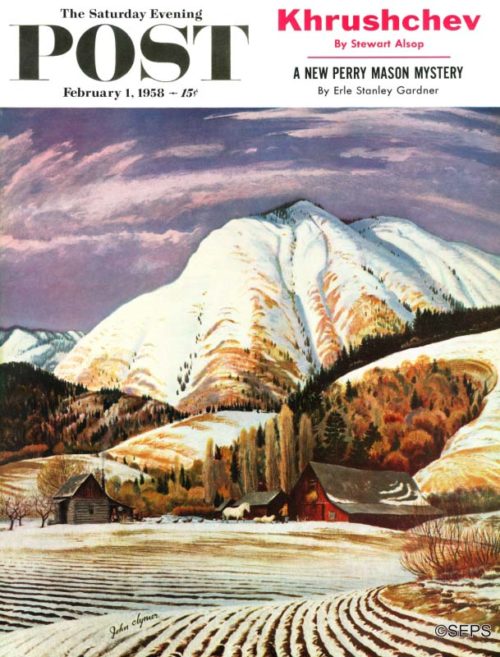
Cascade Mountain Farm
John Clymer
February 1, 1958
At length there’ll come a south-breeze day when the snow on the big hills will give Mr. Frost the heave-ho and begin rollicking down from the skylands in rejoicing cascades. That last word fits in here fine, come to think of it, for John Clymer’s scene is in the Cascade Range.
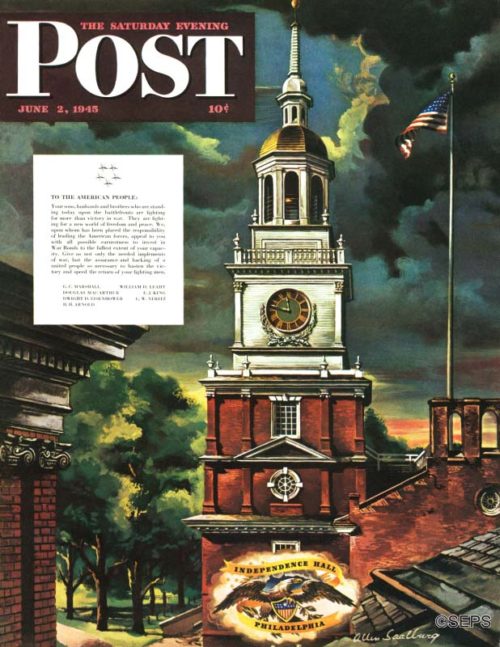
Independence Hall, Philadelphia
Allen Saalburg
June 2, 1945
In 1945, Independence Hall was just across the way from the Post. Allen Saalburg’s painting is a view of Independence Hall looking west. The building at the left was The American Philosophical Society. The Post‘s offices were directly behind the trees in the left foreground.
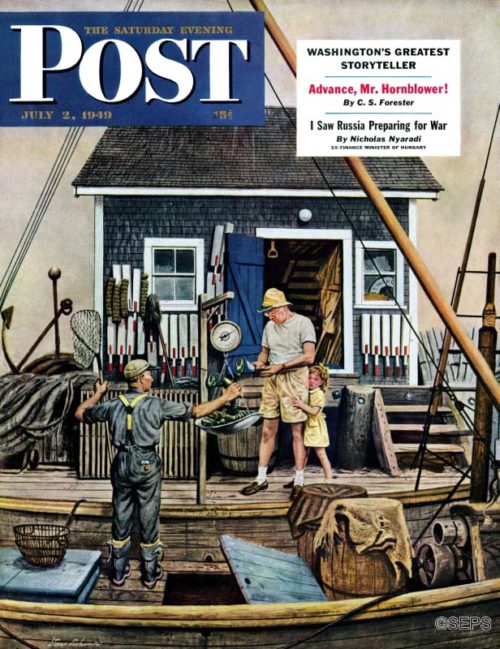
Buying Lobsters
Stevan Dohanos
July 2, 1949
The vacationer in the picture has been caught with that combination of mouth-watering smile and grimace of pain common to human beings when about to pay for a lobster. As for the little girl, you may be too old to recall that the first sight of a lobster is enough to scare the daylights out of anybody. After the first taste, fear vanishes.
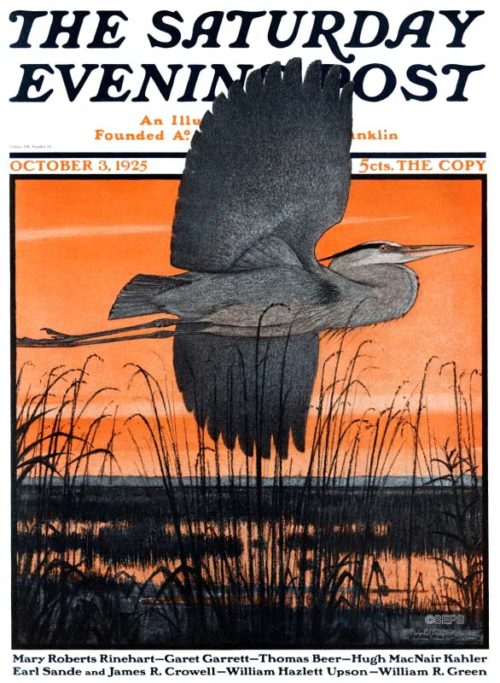
Marsh Bird
Paul Bransom
October 3, 1925
South Carolina has 344,500 acres of salt marsh, the most of any state on the east coast. This regal bird looks as though he’s happy to claim every last one as his own.
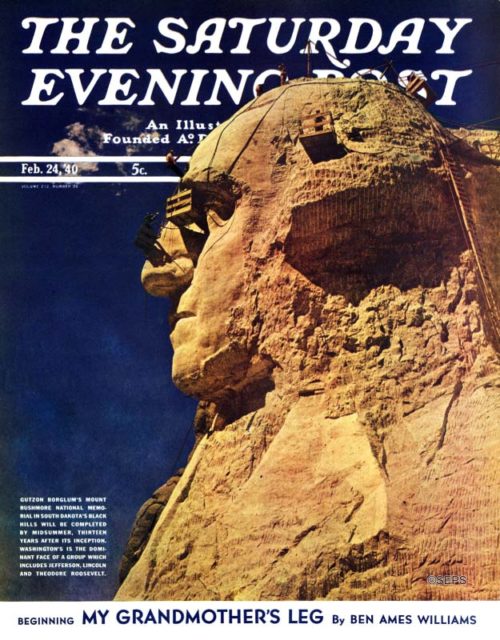
Mt. Rushmore
Lincoln Borglum
February 24, 1940
A photograph instead of an illustration was quite the departure for the Post at the time, but there was important information to document: Mt. Rushmore was scheduled to be completed later that year, so they took the opportunity to capture the monument during its final phase of creation.
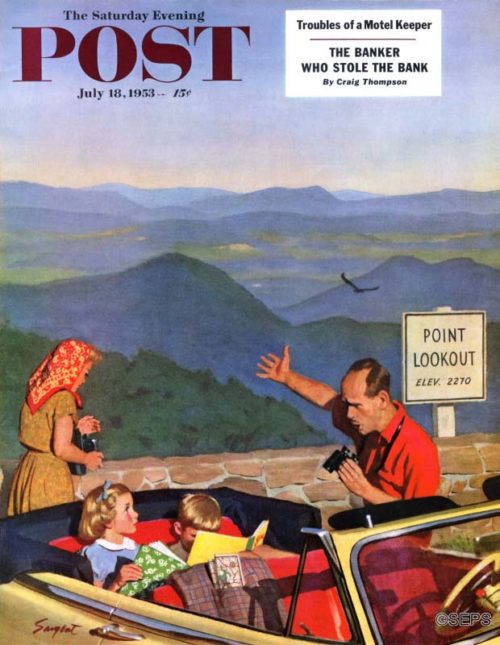
Point Lookout
Richard Sargent
July 18, 1953
Papa has been steering the bus for three days toward Point Lookout, and, having finally made it, is he not justified in decrying the little ones’ disinterest in lookouting? On the other hand, for three days the kids have been peering at interminable scenery; so now that the car has quit jiggling and reading is possible, what is more dutiful than rejoicing in the new hooks that papa bought them to read? Of course, modern readers may long for the days when children were glued to books and not phones.
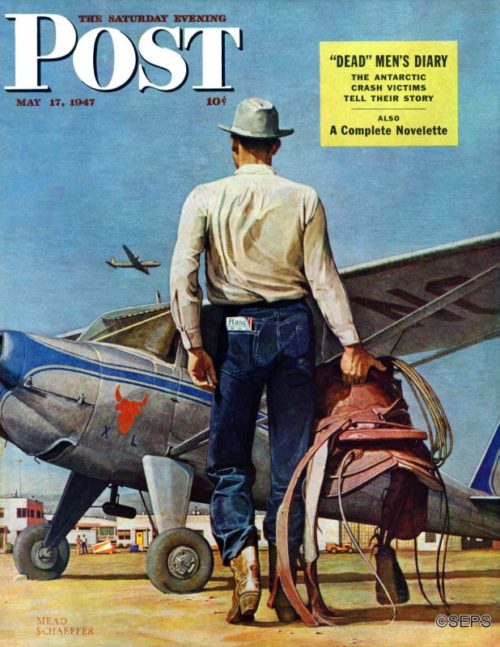
Flying Cowboy/ Airport at Amarillo, TX
Mead Schaeffer
May 17, 1947
“The cowboy carrying his pet saddle to his plane is an everyday sight in the West,” artist Mead Schaeffer wrote when he delivered this painting. “Many a rancher lives in town and commutes to his ranch or ranches by air. The tableland makes landing fields all through the West, and because of the long distances involved, the West takes to planes the way the East takes to cars. Many a business engagement, even luncheon engagements, are kept this way.” One of the flying ranchers, Lee Bivins, was Schaeffer’s model. The background is the airport at Amarillo, Texas.
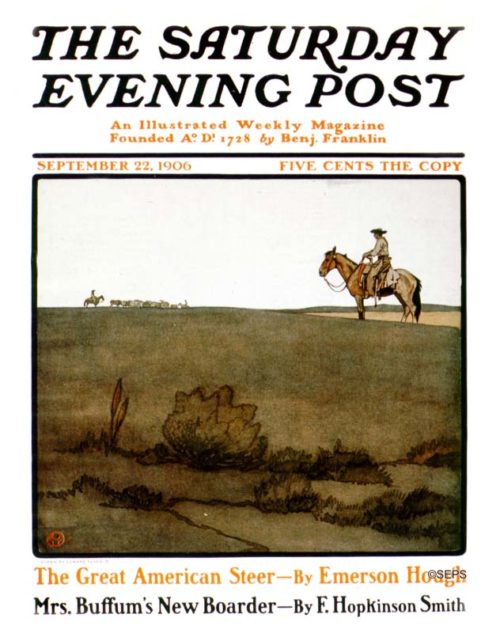
Cowboy
Edward Penfield
September 22, 1906
Artist Edward Penfield is considered the father of the American poster and was an important figure in the field of graphic design. You can see Penfield’s development of the use of simple shapes and limited colors in this work. Are we sure this is Utah? No, but we can’t be too far off the mark.
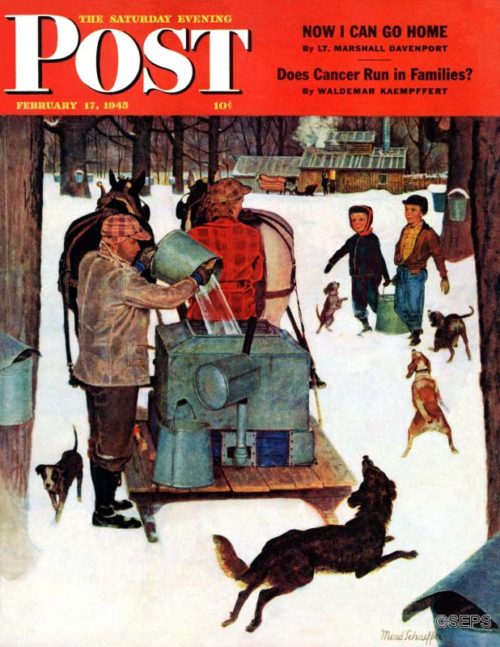
Maple Syrup Time in Vermont
Mead Schaeffer
February 17, 1945
The models are Arlington, Vermont, neighbors of artist Mead Schaeffer’s, Mr. and Mrs. Jim Edgerton and their children. The Edgertons owned one of the best sugar bushes—a bush is a grove of sugar trees—in that section. The shed in the background is the boiling-off house. Vermont farmers can, and do, argue for hours and days over what is the best time to tap. The season starts as early as February and may end as late as April.
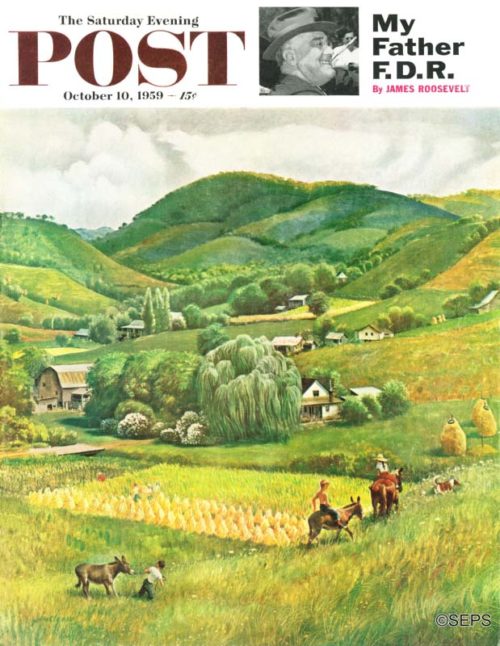
Blue Ridge Burro Ride
John Clymer
October 10, 1959
When those green highlands are seen from afar, they are blue, as highlands are wont to be. Hence, long ago somebody had an inspiration and named them the Blue Ridge Mountains. In the foreground you see a stationary burro, a detail which painter John Clymer probably considers a still life. It’s a pretty fair bet that fifteen minutes from now the animal will still be still.
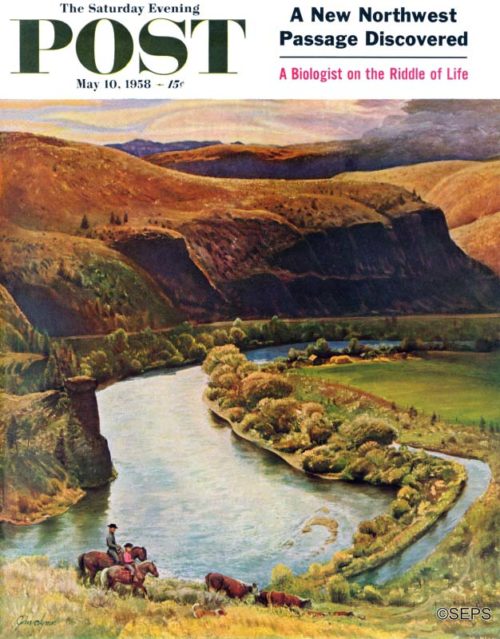
Yakima River Cattle Roundup
John Clymer
May 10, 1958
This is the Yakima River in Washington, not far from artist John Clymer’s boyhood home in Ellensburg; here, one side of the stream (see irrigation canal) is for farming, and the other side for looking. At this river bend Clymer and his father often fished for trout and, furthermore, caught same. In case this lovely spot gives you ideas about temporarily leaving home, just off the bottom of the cover is U.S. Highway No. 10.
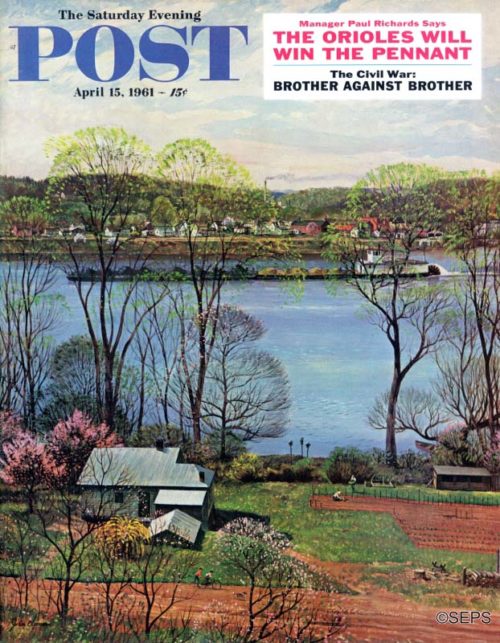
Ohio River in April
John Clymer
April 15, 1961
Heading down the Ohio is a venerable stern-wheeler, push-towing barges loaded with coal and gravel. Cargo by the tens of millions of tons is shipped up and down the Ohio in this manner each year, between Pittsburgh, at the confluence of the Allegheny and Monongahela, and Cairo, Illinois, where the Ohio empties into the Mississippi. (The watershed of the Ohio reaches into fourteen states.) Artist John Clymer formed his riverscape by piecing together the water’s-edge scenes that appealed to him most. The near shore is West Virginia; the far shore is Ohio.
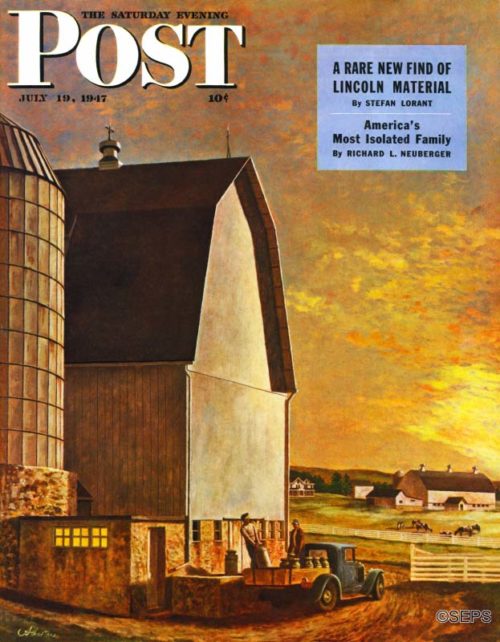
Dairy Farm
John Atherton
July 19, 1947
Artist John Atherton paints an early morning scene in the rich dairy country of Wisconsin, where if all cows are not contented they are hard to please. It’s a section as sleek as its cows, where life has a very high butterfat content. The farm Atherton chose is near New Glarus, in Green County, a town settled in 1845 by Swiss from Glarus, Switzerland.
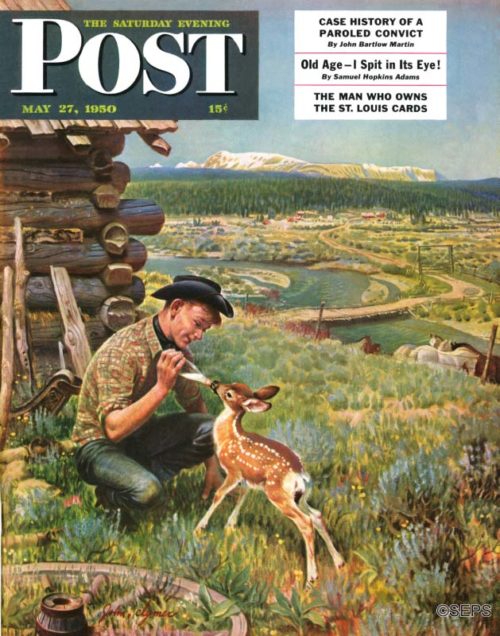
Feeding Fawn Near Flowering Field
John Clymer
May 27, 1950
Boys everywhere have pets; this variation of the pleasant practice is taking place in Wyoming. John Clymer kindheartedly omitted from the landscape the typical haystacks with ten-foot fences around them to persuade horses, cows, elk and high-jumping deer to go elsewhere in search of meals.
Cover Gallery: Bridal Wave
June means the start of wedding season. These Post covers show beautiful brides of the twentieth century.
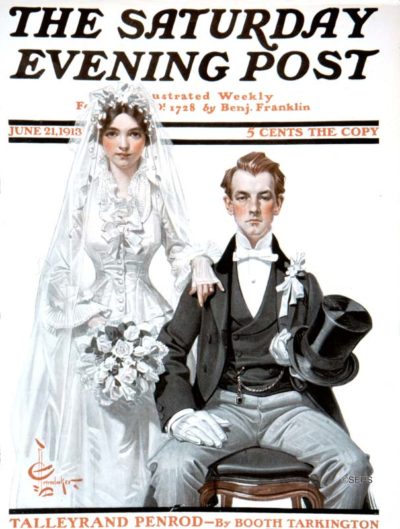
J. C. Leyendecker
June 21, 1913
In this painting by prolific artist J.C. Leyendecker, he shows a solemn couple having their photograph taken. Leyendecker illustrated the nuptial moments of other pairs, including Romeo and Juliet and Henry V and Catherine Valois. It appears this couple has got the “wedded” part down, if not the “bliss.”
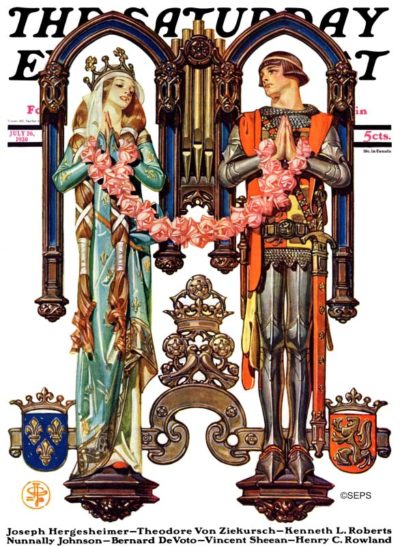
July 26, 1930
J.C. Leyendecker
Catherine of Valois married Henry V in June of 1420 and later gave birth to Henry VI. Henry V died shortly after his son’s birth, leaving the young Catherine a widow and her infant son the King of England.
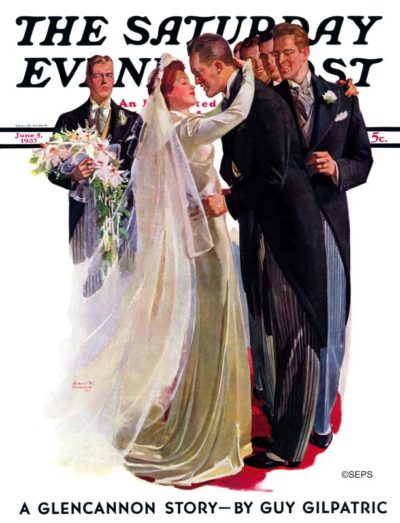
Albert W. Hampson
June 5, 1937
The groom doesn’t look too happy about this scenario. Given the line of enthusiastic groomsmen, the bride may not have enough energy for the honeymoon.
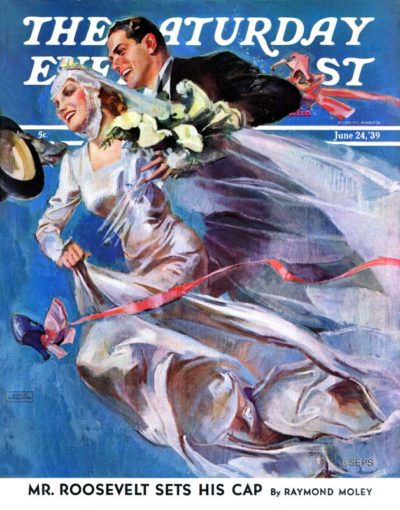
John LaGatta
June 24, 1939
LaGatta had an uncanny knack for translating from model to canvas an appreciation and sensual perspective of the female figure. LaGatta began his artistic process by sketching the models in charcoal and pastels and then would almost always refine his interpretation into an oil painting. His subjects were sophisticated, upper-class men and women with long graceful figures and with classic clothing designs. His images gave the impression that the models didn’t have a care in the world, as in this 1939 cover of a couple running off after their wedding ceremony.
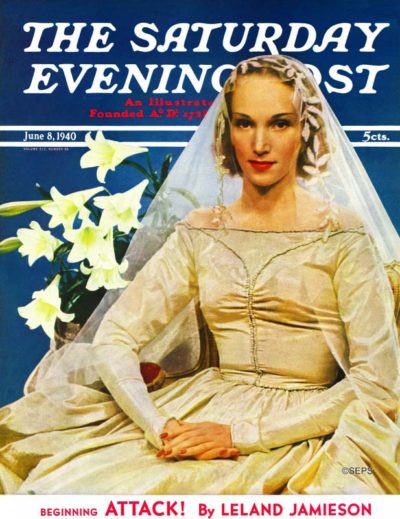
Wynn Richards
June 8, 1940
This 1940 bridal photograph was Wynn Richards’ one and only cover for the Saturday Evening Post. Richards was born “Martha Kinman Wynn” before marrying Dorsey Eugene Richards, according to her biography.. She opened her own photography studio in 1919, but left the business to a friend after a social scandal that involved her taking nude portraits of a local school teacher. Richards divorced her husband and left their son with his grandmother before opening a new portrait studio a few years later. Initially signing her work “Matsy Wynn Richards,” she learned that revealing her gender could hinder her career, and changed her signature to “Wynn Richards.” Richard’s work mostly appeared in Vogue, Harper’s Bazaar, and Mademoiselle magazine.
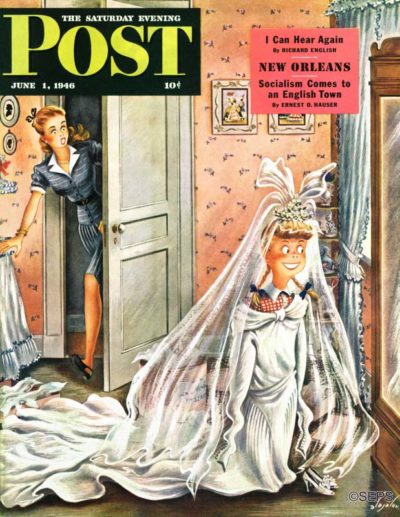
Constantin Alajalov
June 1, 1946
[From the editors of the June 1, 1946 issue of the Post] Just after Constantin Alajalov finished his kid-sister painting, he set out from New York for Florida, to work on other cover assignments. The artist went by automobile, and sent back a short report on his three-day journey. The highways are full of displaced persons at the moment, sorting themselves out after the great disruption of war, and we think Alajalov’s account is a thumbnail picture of America in Transition. “The first day,” he wrote, “I picked up a corporal just back from Tokyo, hitch-hiking to Alabama to marry a girl there. The second day I picked up a marine hitch-hiking to Jacksonville, Florida, to get his wife. The third day I picked up a sailor who was going to Miami for any girl he could get.”
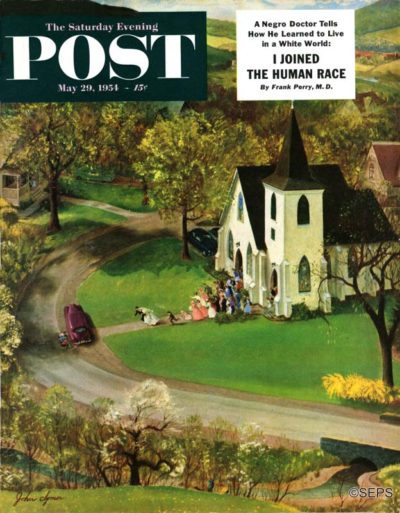
May 29, 1954
John Clymer
[From the editors of the May 29, 1954 Post] Away go the newly-marrieds into their brave new world and thank heaven it isn’t raining. John Clymer is nice about weather; on his covers it hardly ever rains. That church, says Clymer, is located in one state and the landscape in another state, and the honeymoon will take place in the state of bliss always visited on such trips.
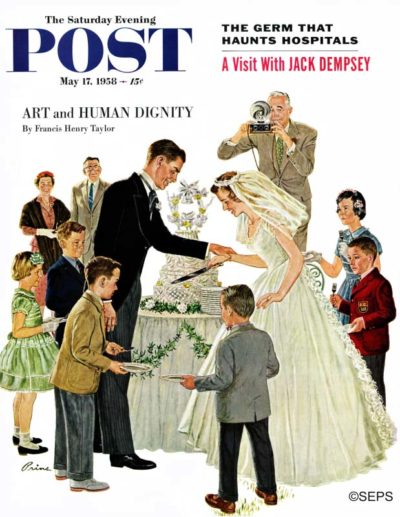
May 17, 1958
Ben Prins
[From the editors of the May 17, 1958 Post] Here come the bride and groom to carve the cake. Two-handed carving isn’t an efficient way to dismember food, but He and She have just become One and this is the tender symbol of their unity. They probably aren’t hungry; in a day or two food will become attractive, but right now they are not of this world, they are up in the clouds, in a state of bliss where folks subsist on love alone. Conversely, those youngsters have their feet on the ground and their eyes on the cake. Oh, the girls may save a few crumbs to put under their pillows to incite romantic dreaming, but the boys will put their cake where it belongs, and let’s hope they don’t consume enough to turn dreams into nightmares. Well, a toast to artist Ben Prins’ newlyweds: bon voyage, all the way through life!
Falling for Autumn
Plunging into leaf piles, playing after-school football, and harvesting pumpkins, these cover scenes embrace the joys of autumn.
Go long! After school lets out, the corner of Sixth Street transforms into a homegrown gridiron. Luckily, an overthrow is an easy feat for the receiver in plaid.
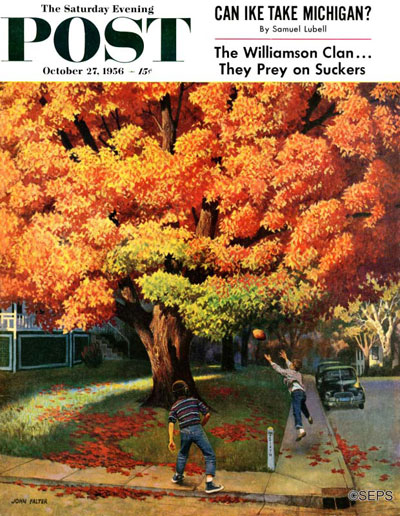
October 27, 1956
She rakes, he dives. Plunging into leaves is the epitome of fall—even the dog seems to agree.
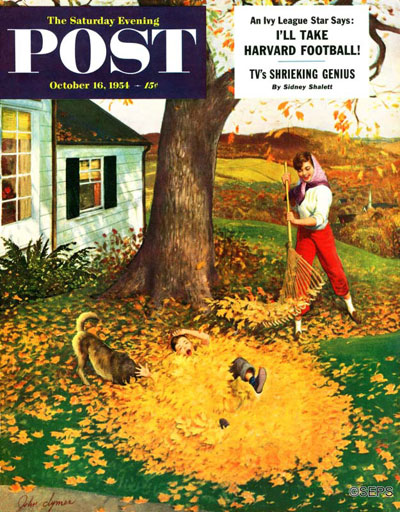
October 16, 1954
Successful day? These boys seem to think so, though Mom might not be impressed with their new pet.
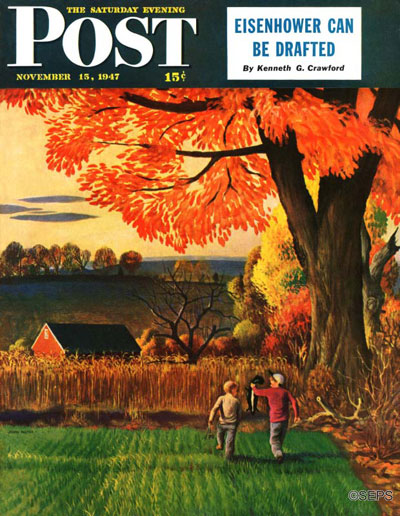
November 15, 1947
With crop season in full swing, the pressure’s on for scarecrows to keep those pesky birds at bay. This one, however, seems to have lost touch with its purpose.
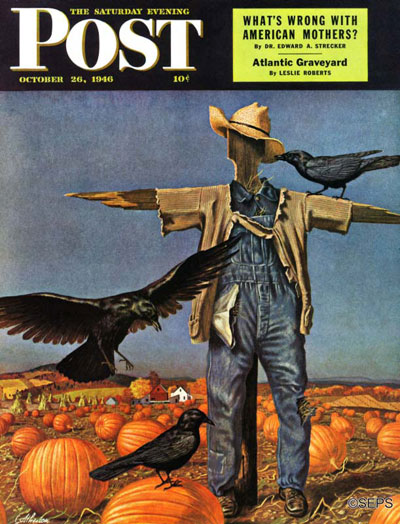
October 26, 1946
Nestling in plain sight might not be the best place for this tom to hide when Thanksgiving is around the corner. Here’s hoping the farmer and his son have other plans for that axe.
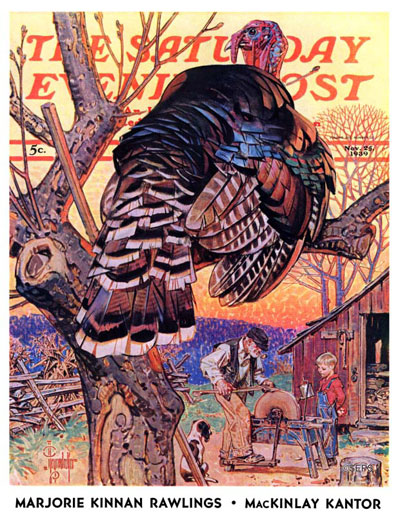
November 25, 1939
“Wait for me!” Best way to ruin a romantic autumn walk? Let your little brother tag along.
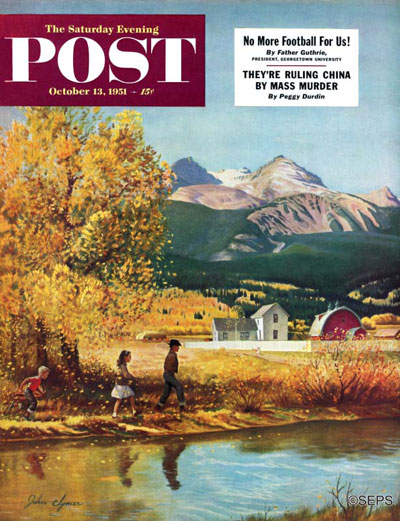
October 13, 1951
People live to gossip, especially when love is in the air. If you have even the tiniest bit of doubt over your new fall fling, we recommend not holding hands in public.
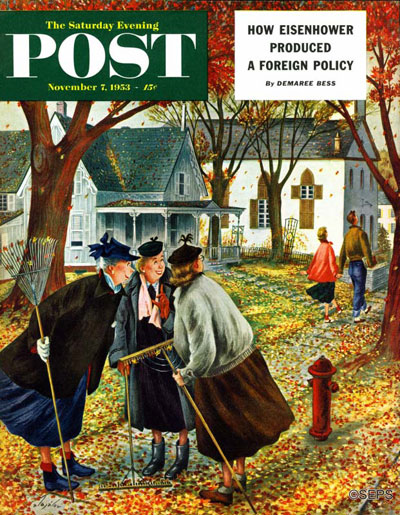
November 7, 1953
Fellas, take note. The odds of getting the girl greatly increase on an intimate horseback ride during the peak of fall. A dream date for sure …
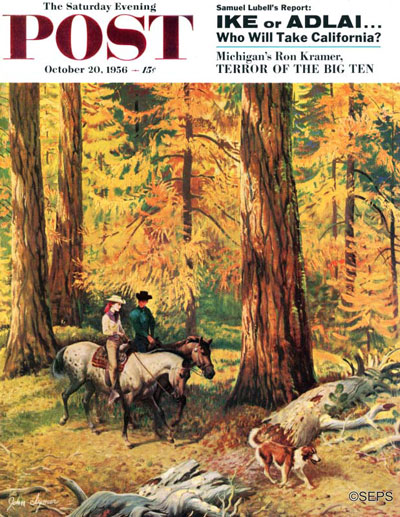
October 20, 1956
… unless she’s afraid of horses. Definitely come up with another plan if her knee-jerk reaction is to hide behind you.
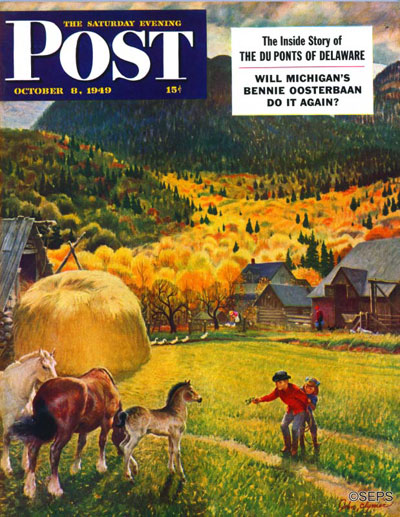
October 8, 1949
Best of the West
The Post Blazes a Trail
In the early part of the 20th century, The Saturday Evening Post commissioned numerous illustrations that collectively helped define the American West for the rest of the country. One of the best known of these artists is N.C. Wyeth, appreciated for his wonderful sense of color and light as well as for being an authority on Western culture.
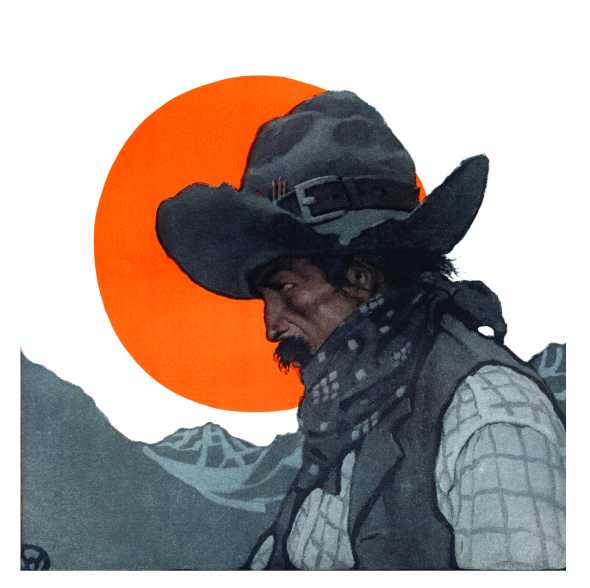
© SEPS
Romantic Vision
A full generation of Americans owe their impression of the soulful, spiritual Native American to artists like Remington Schuyler and W.H.D. Koerner. Interestingly both artists lived, studied, and worked in the east, developing a fascination with Western culture and lore from afar, before making Western art a primary focus.
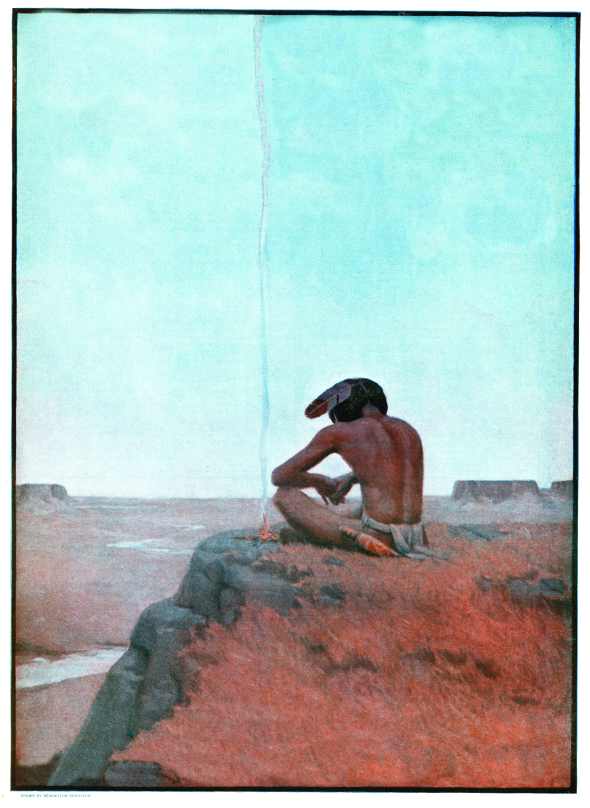
© SEPS
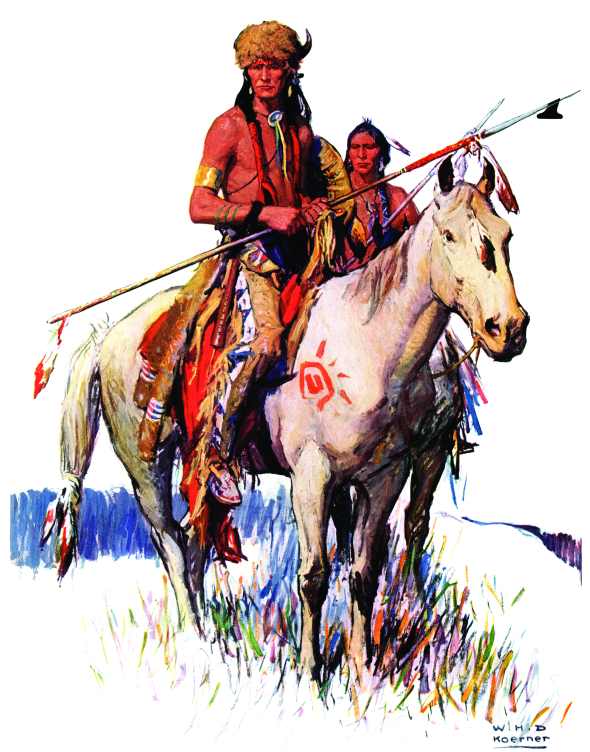
© SEPS
Riders
As a young man, artist Frank Hoffman settled on a working ranch in Taos, New Mexico, using his own horses and other animals as models for his paintings.
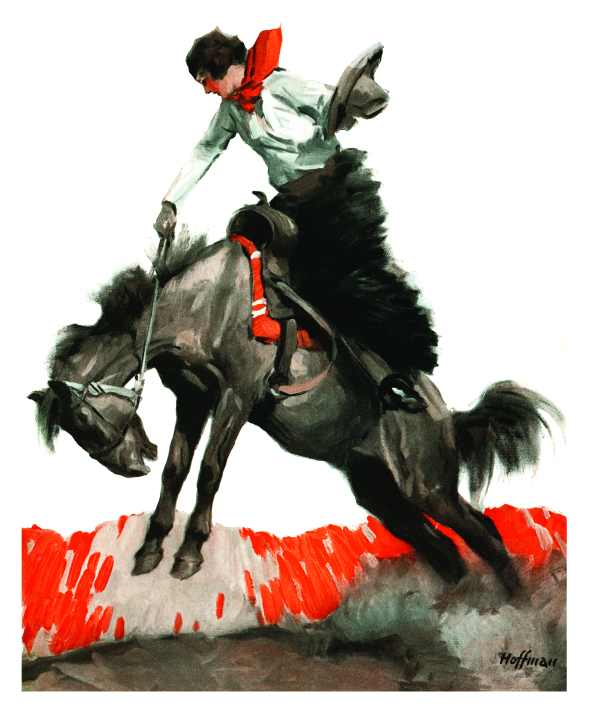
© SEPS
John Clymer painted more than 80 covers for the Post, many of them with Western themes. He’s known for his painstaking research and for the rich historic and geographic detail of his work.
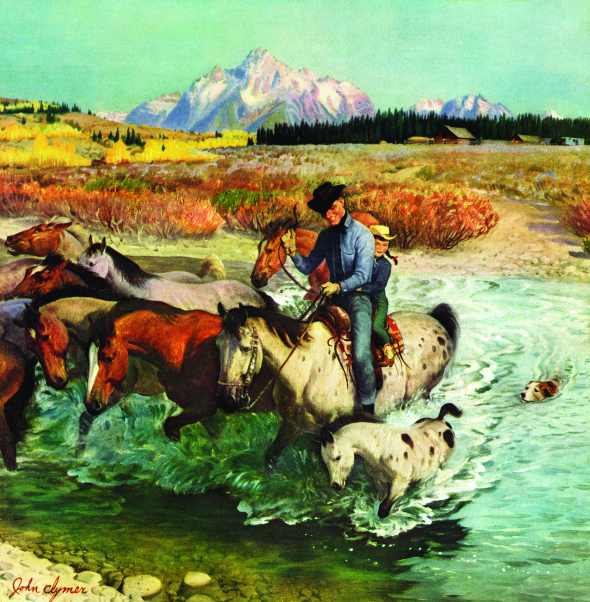
© SEPS
Cowpoke Covers
Our cover artists saddle up to capture the elusive cowpoke of the Wild West. Whether you played rodeo as a child or are a real-life bronco rider, this week’s cover collection is sure to please.
A good cowboy is a resourceful cowboy. And a good horse knows when to stand still.
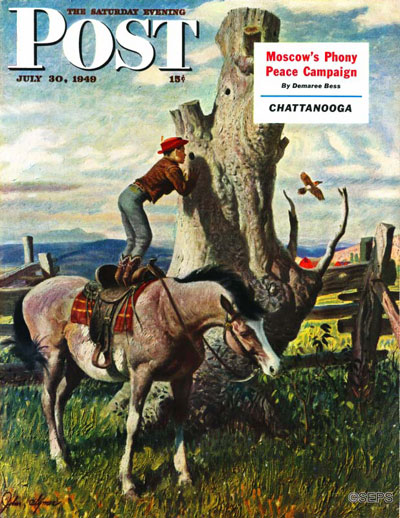
July 30, 1949
Saddle up, partner! This cowgirl looks like she can hold her own.
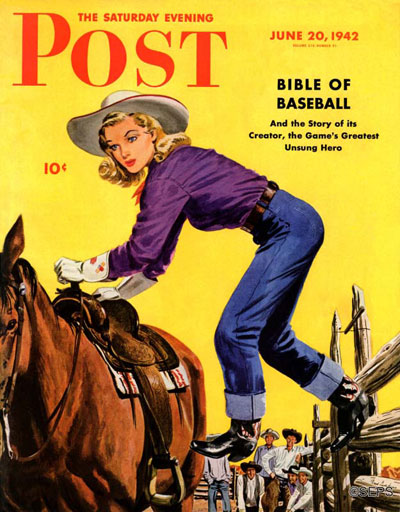
June 20, 1942
These three little gunslingers may be the fastest hands in the neighborhood, but any make-believe cowboy worth his weight in cap guns knows that true grit is determined by how long you can play dead without opening an eye.
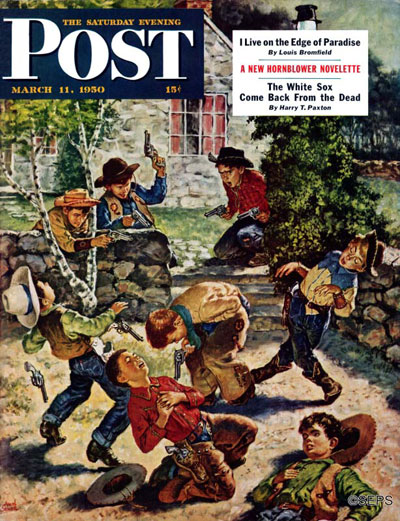
March 11, 1950
Lights, camera, action! To play a cowboy, not only is it important to act the part, you have to look it, too. Bring on the lipstick.
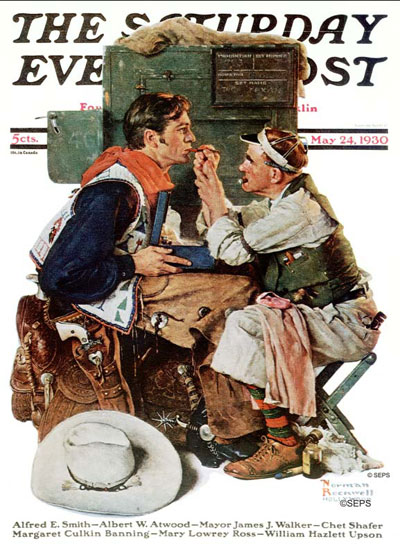
May 24, 1930
Who doesn’t adore a good old-fashioned cowboy? Clearly, this cowpoke knows his duds will never go out of style.
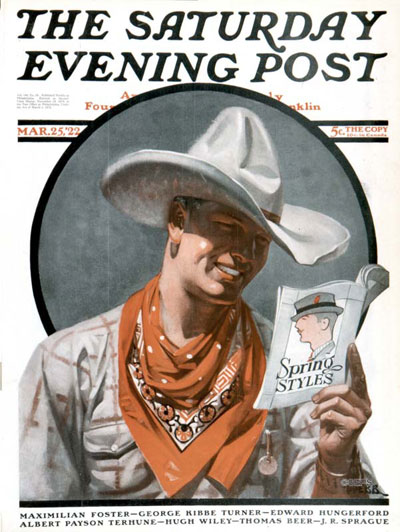
March 25, 1922
Working hard or hardly working? Judging by that pool of water and the boy’s flushed face, we’re going with the former.
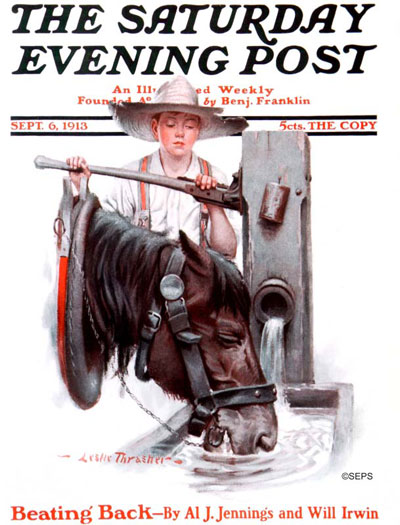
September 6, 1913
That little cowboy must taste as sweet as he looks — prior to the tears, of course.
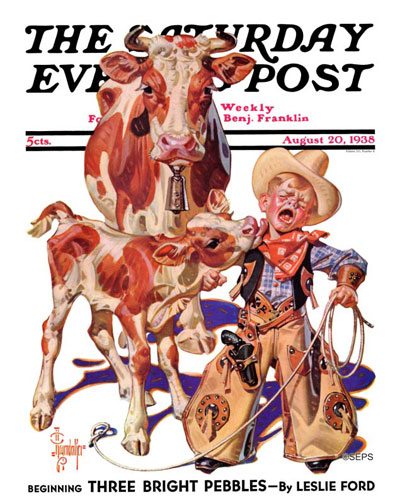
August 20, 1938
ck out the September/October 2015 issue for a look at works of Howard Terpning, one of the today’s masters of Western art.
Summer Fun
It’s the season of empty classrooms, sleepy afternoons, and mercury rising up the meter. These covers offer a glance at the happy-go-lucky methods of sun-baked escapism for adults and kids alike.
Sliding into Water – Lawrence Toney
Sand between your toes and surf lapping at the shore is fine and good, but the neighborhood waterslide can serve just as well. For some, a pair of trunks and the rush of gravity are more than enough to beat the heat.
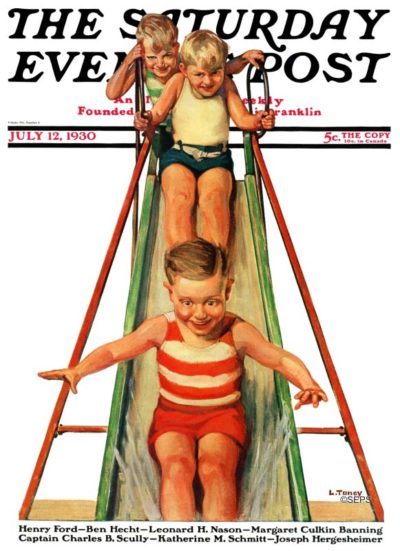
July 12, 1930
Water Fight – Thornton Utz
Providing the water supply holds out, a little mirth and mayhem can turn a suburban lawn into an amphibious battleground. Thorton Utz’s work is a giddy cautionary tale for everyone walking by to hike up their socks.
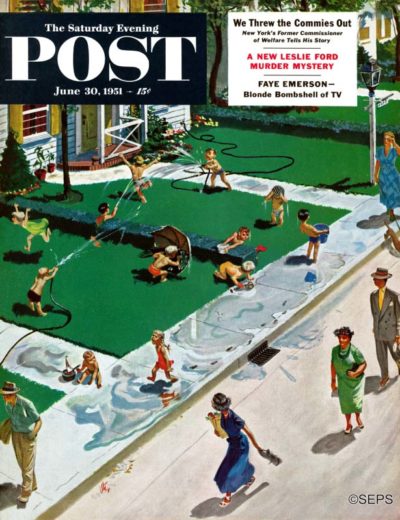
June 30, 1951
Croquet Game – John Falter
The family tournament portrayed in John Falter’s Croquet Game makes for a fitting post-Sunday dinner capper as the sunlight steadily trickles away.
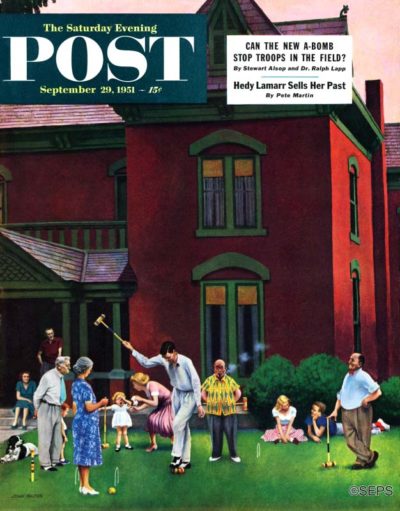
September 29, 1951
No Girls Allowed – Stevan Dohanos
A ramshackle paradise tucked into the trees makes the perfect lazy afternoon retreat for the adolescent crowd still harboring fears of a cootie outbreak. With trumpet, pooch, and crossbones all aloft, they can’t want for much.
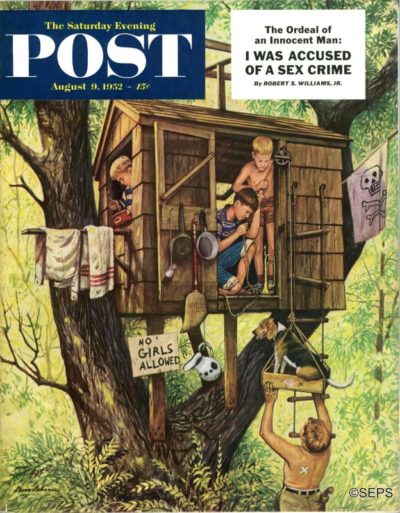
August 9, 1952
Feeding the Elephants – John Clymer
Getting up close and personal with a pair of curious pachyderms may be the thrill of the afternoon, but that motley bouquet of balloons just beyond the elephant habitat is sure to draw some new customers in the immediate future.
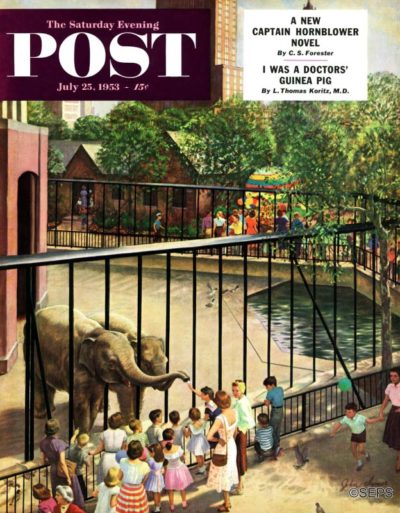
July 25, 1953
Town Green – John Clymer
A tot jamboree, future hall-of-fame hopefuls, and lounging bookworms round out the cast of John Clymer’s sprawling Town Green, where all can bask in the stippled shade around the gazebo.
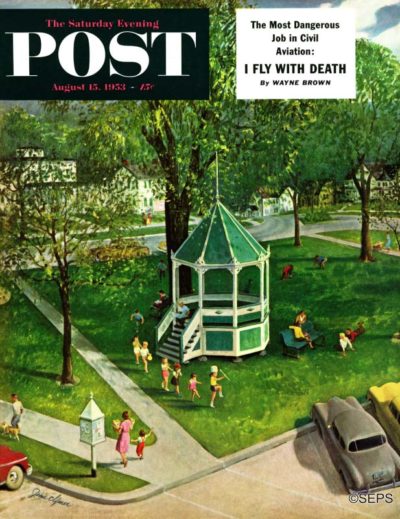
August 15, 1953
Backyard Campers – Amos Sewell
A bump in the night is never welcome when all you have are tent flaps for defense. And a few ghost stories too many can render the most innocuous cicada chirp into a sinister bogey-beast on the prowl.
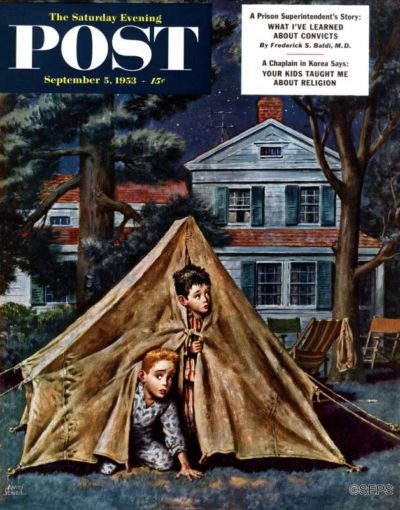
September 5, 1953
Lemonade for the Lawnboy – George Hughes
A shiny quarter would be welcome, but when trimming the lawn in the sticky heat of early summer, payment in icy fresh-squeezed lemonade is just as appreciated.
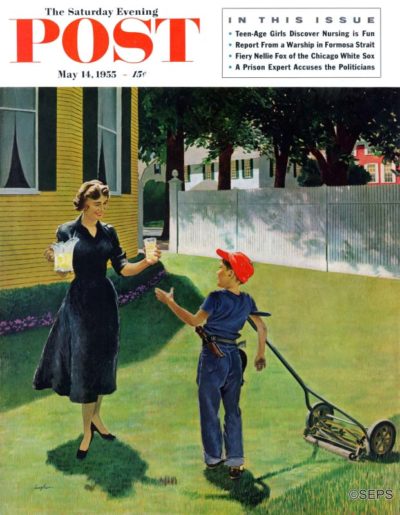
May 14, 1955
Wading Pool – Amos Sewell
Even if one size doesn’t fit all, when the kiddie pool is the only escape from August heat, most are willing to make due. You snooze, you lose.
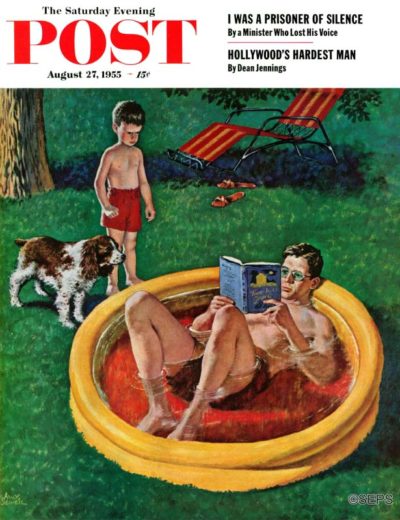
August 27, 1955
Swing-set – Amos Sewell
With shoddy materials and blueprints more complex than the Manhattan Project’s, dad may end up getting better exercise than the kids. Luckily for his patient audience, this dance more than makes up for the lack of functioning swings.
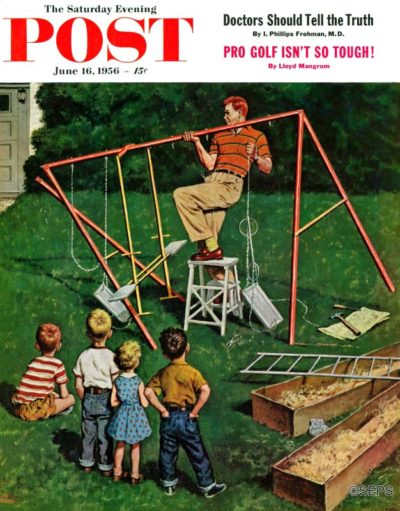
June 16, 1956
Billboard Painters – Stevan Dohanos
In mid-July swelter on the cusp of a scorching third digit, these workingmen are wise to take the advice of their arctic billboard. Unfortunately, no amount of wishful thinking can convince their fictional polar pals to share the snow.
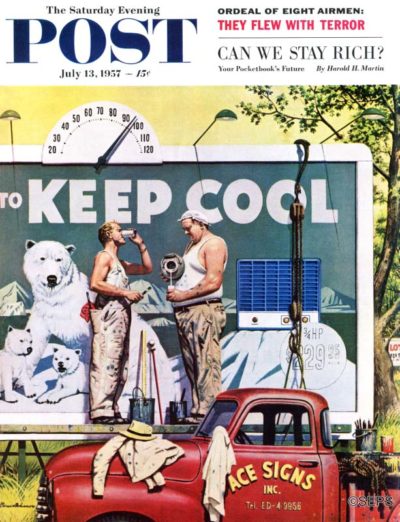
July 13, 1957
Where the Girls Are – Thornton Utz
As shown in Thorton Utz’s Where the Girls Are, the discerning college boy always has one eye open for opportunity, even in excess of the speed limit.
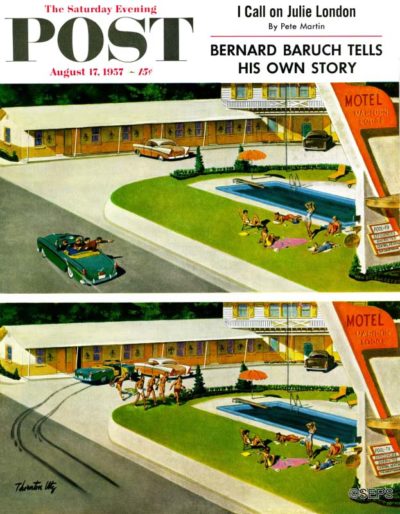
August 17, 1957
John Clymer
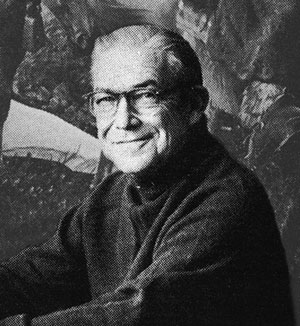
John Clymer began his life on the west coast, but spent much of his career out east working in illustration and advertising. Born in Ellensburg, Washington in 1917, Clymer grew up fascinated by natural art at the foothills of the Cascade Mountains. Over the course of his life, he nurtured his love of nature and eventually became most famous for his depictions of the iconic American west. His parents, John and Elmira Clymer, lived simple lives owning a greenhouse and florist business together.
John was not an academic child. He preferred doodles and staring at the landscape outside the classroom window over paying attention to adults. In his youth, the local Presbyterian pastor halted his own sermon to tell John, who was sitting in the back, to stop drawing in the hymnals.
Covers by John Clymer
Walking on the Fence
John Clymer
December 4, 1954
Fishing on Mountain Lake
John Clymer
July 16, 1955
Rocky Mountain Fly Fishing
John Clymer
May 5, 1956
John’s interest in art began when his parents subscribed to magazines offered by a traveling salesman. At the onslaught of viewing those first professionally illustrated images, John Clymer knew he wanted to be an artist. Since there were no art schools nearby, John joined a federal correspondence course. While still in high school, his friends and classmates encouraged his budding talent. He designed local advertisements for the town rodeo, and even received commissions from Colt Firearms.
Upon graduating high school, Clymer moved up to Vancouver, Canada where he spent eight years illustrating for various Canadian magazines and advertising firms and attending art school classes at night. As his popularity grew, Clymer realized that the most profitable work was on America’s east coast.
In 1932, Clymer married his childhood sweetheart, Doris, and together the two moved to the artist’s colony of Wilmington, Delaware. John went back to school, choosing to study commercial art at the Wilmington Academy of Art. His professors there were some of the greatest names in American illustration, including N.C. Wyeth and Frank Schoonover, each a former student of the great Howard Pyle. After five years there, John and Doris moved to Westport, Connecticut in 1937.
By the 1940s, Clymer’s career on the east coast had taken off. He provided illustrations to such magazines as Argosy, Woman’s Day, Field and Stream, and his first Saturday Evening Post cover on the January 31st, 1942 issue. Clymer created over 80 covers for The Saturday Evening Post between 1942-1962, often portraying patriotic or western scenes.
Once World War II began, Clymer joined the Marine Corps with his artistic partner, Tom Lovell. At age 35, the artists were a little too old to fight on the battlefield. The two were assigned jobs creating illustrations for the Marine Corps magazines Leatherneck and The Marine Corps Gazette.
After the war, John returned home to focus on raising his children and creating new art. Alongside his successful magazine illustration business, John had a large stable of advertising clients including White House Scotch Whiskey, The Pennsylvania Railroad, and The Chrysler Corporation.
With the decline of illustration, Clymer and his wife moved to Jackson Hole, Wyoming in 1970 and stayed there the rest of their lives. He kept a studio out there where he produced paintings of the landscapes and imagined iconic western scenes.
In 1976 he received the prestigious Prix de West Award from the Academy of Western Art. He also received medals from the Cowboy Artists of America, Western Artist of the Year from the National Wildlife Art Collectors Society, and in 1988, he received the Rungius Medal from the National Museum of Wildlife Art.
The artist died in 1989 and has been named a member of the Royal Canadian Academy of Arts. Today, many of his famous paintings and illustrations rest in The Clymer Museum of Art in his original hometown of Ellensburg, Washington.
Beyond The Canvas: The Myth of The American West
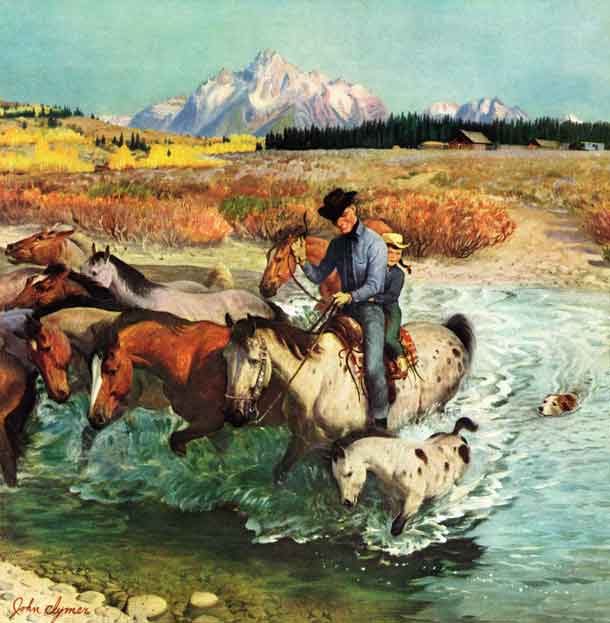
John Clymer
The Saturday Evening Post
There are few Post cover artists who so appreciated the American west as much as illustrator John Clymer. Born in the Pacific Northwest in Ellensburg, Washington, the artist grew up with vast landscapes of mountains and untouched plains reaching to the horizons.
America’s natural terrain charmed Clymer from a young age. He was taken by the mythos of the American west, of cowboys and Indians, and the thrill of adventure.
Clymer’s September 13, 1952 cover, “Herding Horses,” embodies the spirit of the American west. In this depiction, a rancher herds his livestock, fording them across a river on the plains. With his own young daughter saddled behind him, the cowboy smiles down on a colt struggling to navigate the waters.
The composition of the painting gives equal focus to the bounty of the surrounding natural elements, as well as the human involvement in living off the land. The top half of the work shows the snow-capped mountains in the distance complete with rolling hills and forest beneath. Sprinkled throughout are the farmsteads of ranchers and farmers who live off the land.
The artist’s decision to use the American Mustang for the river-crossing livestock instead of cattle or oxen adds to the overall wild and untamable nature of the American west. A feral horse that interbred with the European thoroughbred, it became a wild animal on the American plains. Their spots are a noticeable feature of their uncontrolled breeding in the wild. Note that Clymer’s rancher chooses to ride the most spotted mustang of the group rather than a monochrome horse of his herd. This symbolizes the cowboy’s ability to tame the Wild West.
Clymer used a vibrant color pattern to expose the beauty of nature and the change of seasons. A master of illustration who studied under N.C. Wyeth, Clymer shows off his artistic finesse in the clarity of the stream. His ability to successfully illustrate clear water, the rocks beneath, and the horses’ shadows upon the ripples is a testament to his artistic daring.
In fact, Clymer’s well-rounded training is evident throughout the entirety of the work. He is capable of drawing humans, as is evidence by the man and child on horseback. He flawlessly composes the equine trot, one of the most difficult animal forms in motion.
John Clymer was a master of his genre, and his passion for the land translates well onto canvas. Today, his work is well respected and highly lauded by western art museums and societies across the country. His artwork not only maintained but enhanced the myth of the American west. Many of his original paintings and illustrations are on display at the Clymer Museum of Art in Ellensburg, Washington.
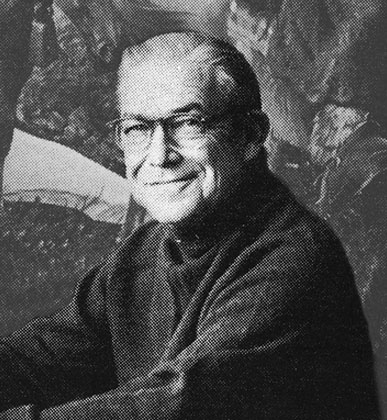 To learn more about John Clymer and to see other inside illustrations and covers from this artist, click here!
To learn more about John Clymer and to see other inside illustrations and covers from this artist, click here!Classic Covers: For the Birds
We’ve all been fascinated, even envious, of our feathered friends, and our cover artists have helped us our with our bird watching. From these beautiful nesting orioles to daunting birds of prey, Saturday Evening Post and Country Gentleman magazine covers run the gamut—and the seasons—of bird watching. Come fly with us!
Man Feeding Birds by R. Bolles
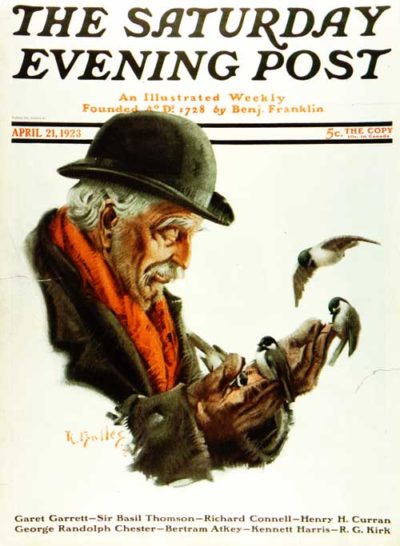
I’m not familiar with artist R. Bolles, but this is the cover that got me started on this quest. I knew there must be more beautiful covers with birds, and there were many. The elderly man feeding the birds with such gentleness reminded me of a better-known cover by Norman Rockwell the same year (below).
Farmer and the Bird by Norman Rockwell
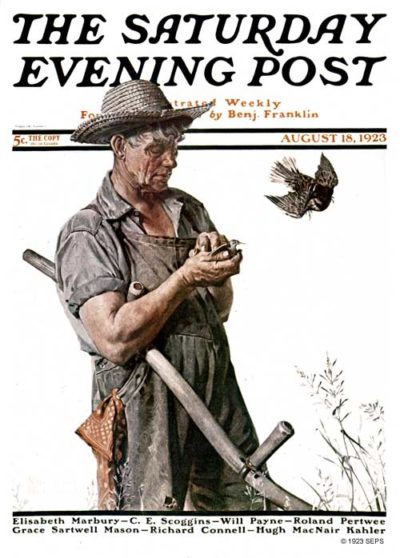
The “Farmer and the Bird” is a Rockwell favorite. There is a touching contrast between the delicate fledgling and the hard-working ruggedness of the farmer. Rockwell loved old hats and well-worn clothing and kept a supply of such items for his models. If he was going for a strong, rough look, he picked the right model and knew how to make him look even more so.
Harbinger of Spring by John Clymer
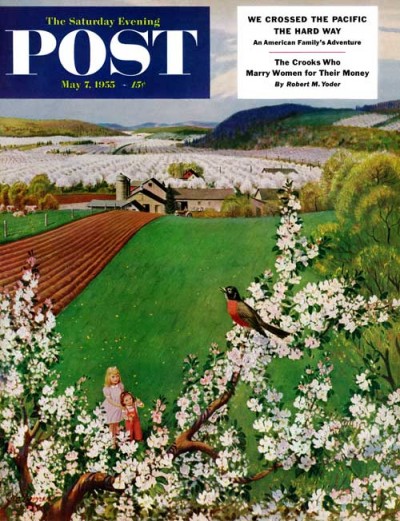
Oh, to be a bird in a beautiful John Clymer landscape! If the two little girls didn’t already know it was spring from the fact that dad’s tractor is running again in the background and from the achingly beautiful apple blossoms, Mr. Robin Redbreast is hailing the season from his perch. If you need a more detailed look, you can click on the cover.
South for the Winter by John Clymer
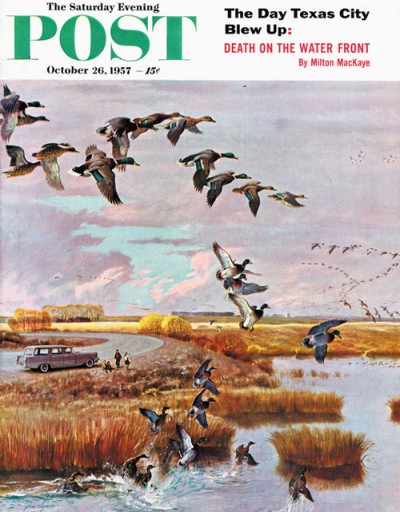
Artist Clymer again, because who did nature better? This time it’s mallards flying south for the winter. The vastness of the sky is beautifully executed with the pastels of dusk (or dawn). You can almost feel that new nip in the air. A family has pulled the station wagon over to observe the feathered flight and if you want a closer look, you can click on the cover. This is a migratory flyway in the lakelands of Alberta.
Snowy Owls by Don Bleitz
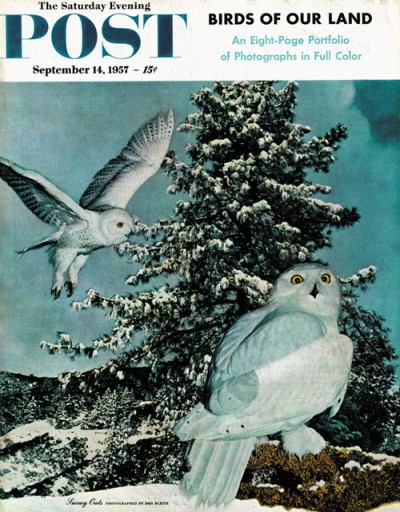
“Through Don Bleitz’s photographic skill let’s go calling on Mr. and Mrs. Snowy Owl in their country home near Edmonton Alberta. That’s the Mr. gazing at you from his living room, and the Mrs., smartly arrayed in her chic polka-dot ensemble, is just getting home from somewhere or other.” –Post editors, September 14, 1957. Yes, in the 1950’s, most Post covers were artist renditions rather than photographic, but happily, this photo slipped through.
Owl and Rabbit by Paul Bransom
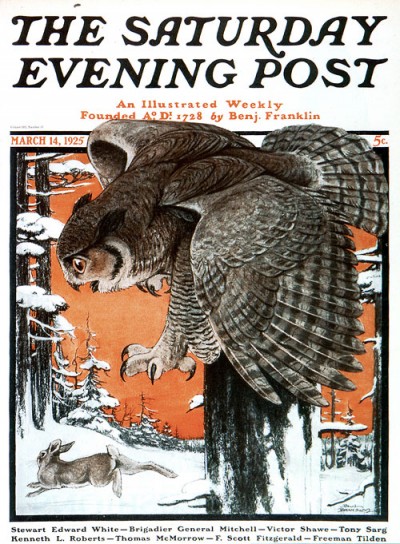
Born in 1885, Paul Bransom was a well-known wildlife painter. His Post and Country Gentleman covers boasted everything from leopards to foxhounds. This one shows the wild side of nature with the great owl honing in on a rabbit who senses he is about to become dinner. Oh, and Bransom did great roosters – I have to share one more (below).
Fancy Rooster in Mirror by Paul Bransom
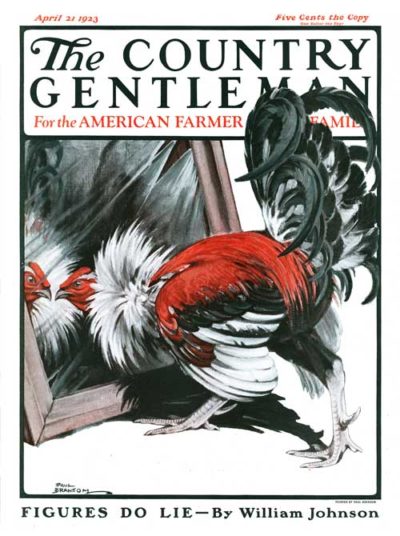
Country Gentleman was a sister publication to the Post, and another great spot for a wildlife illustrator to land. I couldn’t resist this preening rooster checking himself out in a mirror from 1923. Okay, okay – you’re handsome, already. Reprints of Country Gentleman covers, like those from the Post, are available at curtispublishing.com.
Classic Covers: John Clymer’s Beautiful Seasons
Autumn is almost here, so this seems like a good time to celebrate the seasons. Most people have forgotten the beautiful scenery by great landscape artist John Clymer that graced over eighty covers of The Saturday Evening Post. Enjoy this reminder – and you can click on any cover for a close-up.
Mountain Farm by John Clymer
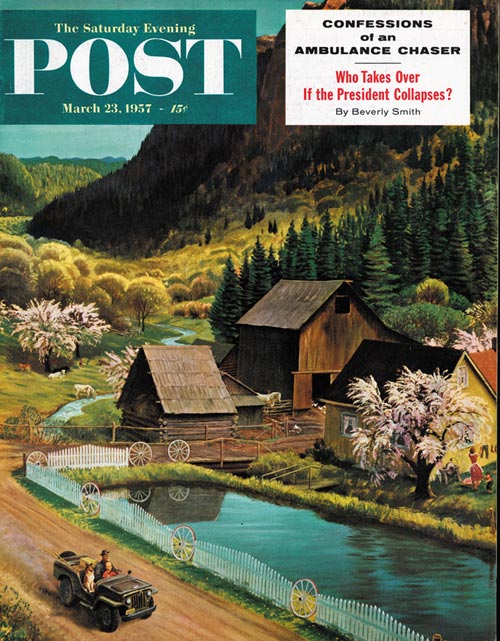
John Clymer
March 23, 1957
“When I got into my early teens, like all boys, I got to wondering what in the world could I do to make a living and live in the mountains? One day I got to thinking about it and thought, that’s it! I’ll paint pictures and then I can live wherever I want to live.” – John Ford Clymer (1907-1989)
Born and raised in Ellensburg, Washington, Clymer was used to mountains and this 1957 springtime was painted from memory. The viewer almost feels like he is in that jeep, riding along with the collie alongside the clear water and breathing the fresh air. There’s a lot of detail here…you can barely see the woman hanging clothes to the right.
Colorado Creek by John Clymer
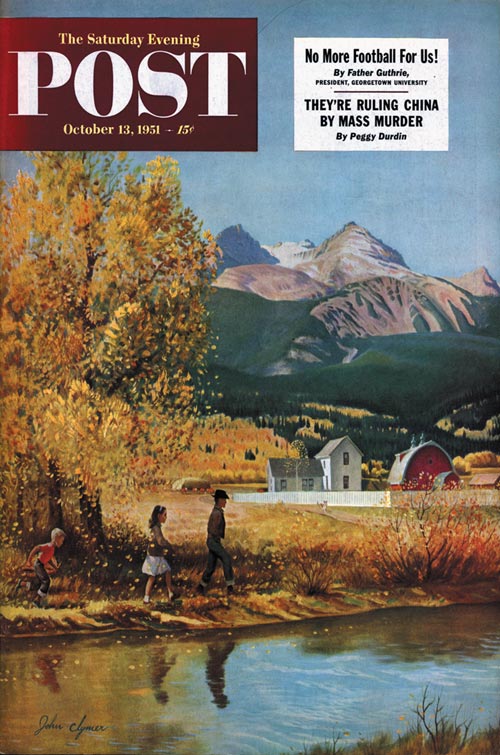
John Clymer
October 13, 1951
In the foothills of the Rockies, this 1951 cover is another example where you can almost breathe the tonic of the autumn air. Until a traveling magazine salesman sold the Clymer family some subscriptions, John did not have a clue as to what his future held. Entranced by the illustrations, he came across a correspondence course and worked toward honing his artistic talents.
Gloucester Harbor in Winter by John Clymer
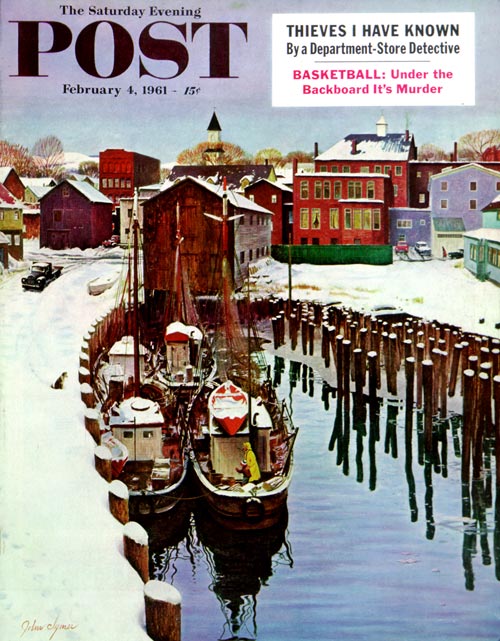
John Clymer
February 4, 1961
Crisscrossing the country, Clymer traveled to Delaware to study at the Wilmington Academy of Art. So naturally, not all scenes were from his Western perspective, although his heart remained in the Cascade mountains. This cover shows a picturesque New England view- Gloucester, Massachusetts harbor in the snow. Note the fisherman and tiny boy on a boat in front.
Children with Rowboat by John Clymer
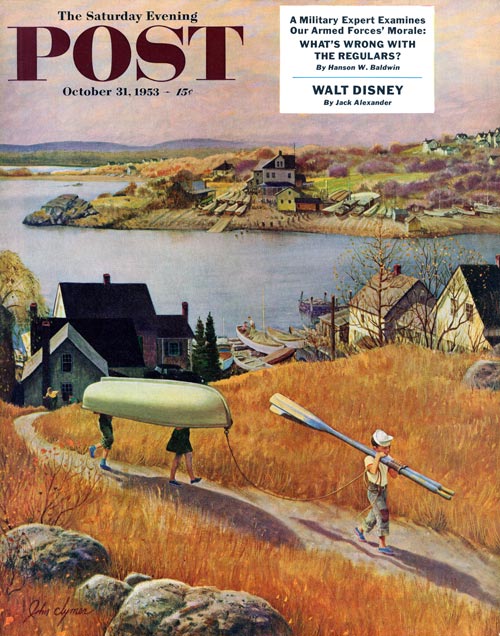
John Clymer
October 31, 1953
Honestly, I could just kick myself. A few years ago a gentleman called and asked about this cover. “You see that house in the background, behind the kids?” he asked. “I just found out about this painting – that’s my house!” The reason I could kick myself is I didn’t keep his name. But we can still enjoy John Clymer’s late fall painting from 1953.
Skipping Stones by John Clymer
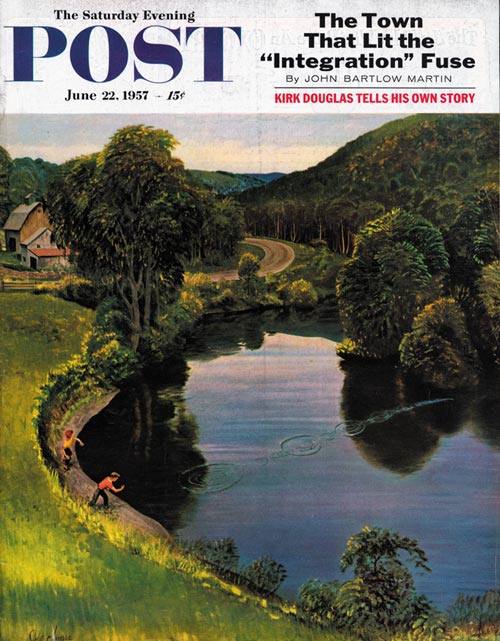
John Clymer
June 22, 1957
One of the prettiest reminders of summer is this 1957 treasure. “Glory be!” exclaimed the Post editors, “School’s out and there’s nothing to do for a billion tomorrows except nothing much. At least until dad starts getting notions in his head, such as that it won’t harm the vegetable garden to hoe it.” In the meantime, skipping stones seems like a nice thing to do. “Another nice thing,” the editors noted, “is the loveliness of the land that John Clymer always gives his people to live in.” As always, reprints are available at curtispublishing.com.
Classic Covers: “Covering America” Art Show
The Post is proudly showing off paintings it made famous in your parents’ living rooms each week. The “Covering America” Art Show will be in Lafayette, Indiana (at the Art Museum of Greater Lafayette) from May 21 – September 11, 2010, with plans in the works for future exhibitions. From stunning landscapes to rousing brass bands, from churches to baseball fields, The Saturday Evening Post cover artists presented America during the 1950s and 1960s like no other medium. Come take a peek!
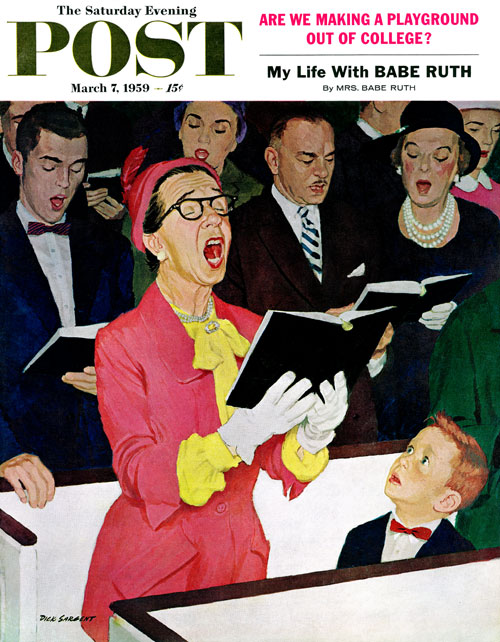
Singing Praise
Dick Sargent – March 7, 1959
“Never before has that little boy heard anything like Mrs. Bellows,” the editors said of this painting. Typical of artist Dick Sargent’s delightful humor, “Singing Praise” was a cover in March 1959. We don’t have to tell you the boy’s face is priceless (but we’ll say it anyway).
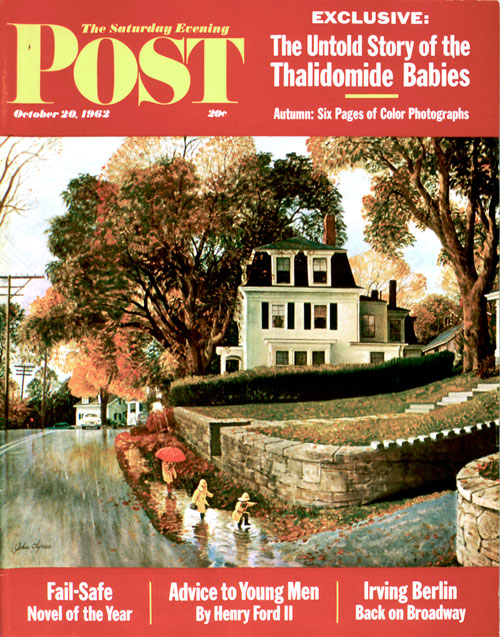
Walking Home in the Rain
John Clymer – October 20, 1962
The exhibit features several John Clymer covers, and this one from 1962 combines the artist’s talent for painting nature with a charming scene of children walking home in a chill autumn rain. The artist came across the scene in Rockport, Massachusetts while traveling and “looking for Americana”. “If there is a puddle to be found,” the artist noted, “kids will find it and walk in it.” Well, gee, isn’t that what boots are for?
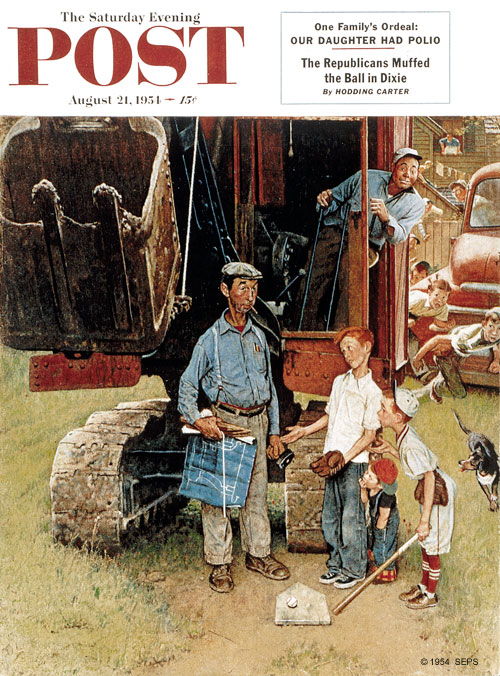
Construction Crew
Norman Rockwell – August 21, 1954
This is progress? Home plate is giving way to the bulldozer for a new house. Always one for authenticity, Norman Rockwell found the boys by knocking on doors in Stockbridge and asking for members of the Little League team. Some were used as models in later covers. Is the tiny boy sucking his fingers too cute or what?
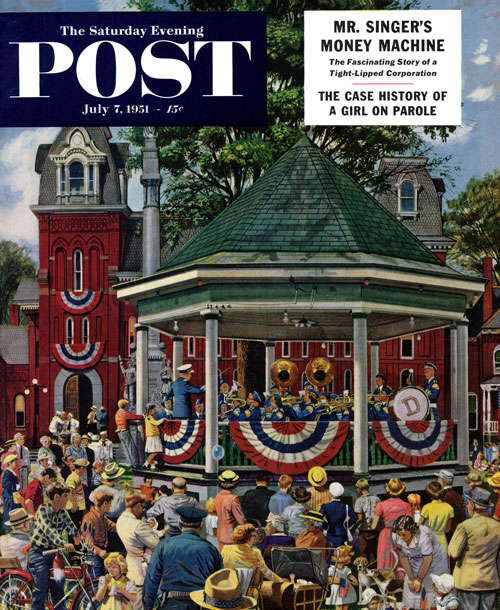
Patriotic Band Concert
Stevan Dohanos – July 7, 1951
Stevan Dohanos did over 120 memorable Post covers, and readers loved this one from 1951. There is a lot going on at this Fourth of July concert in Delhi, New York. Grandparents listening, dogs and kids checking things out, sailors chatting, and tiny tots are having meltdowns. The editors noted, “When Dohanos set up his easel opposite Town Hall, passers-by forgathered to see why, and the first thing they knew, the were on canvas.”
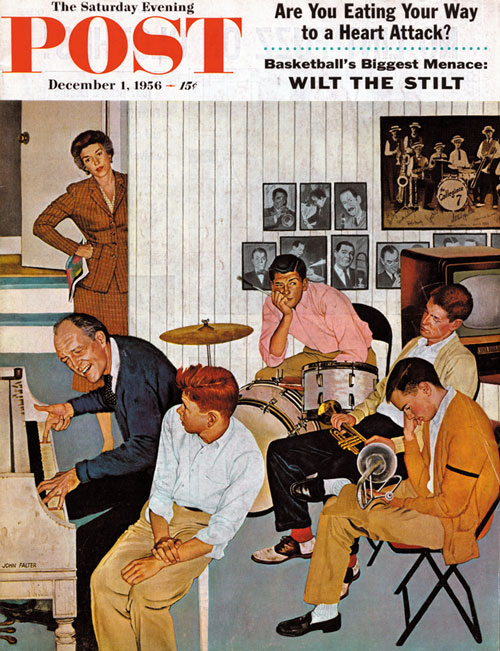
Jamming with Dad
John Falter – December 1, 1956
Dad crashes junior’s jam session and the guys are, well, less than enthused. Artist John Falter also did well over 100 Saturday Evening Post covers, and life with kids was a favorite topic. Note the college band photo on the wall – straw boaters and all. The photo montage of jazz greats gives us a clue to the type of music dad finds cool, and the kids…well, let’s just say they don’t dig all that jazz.
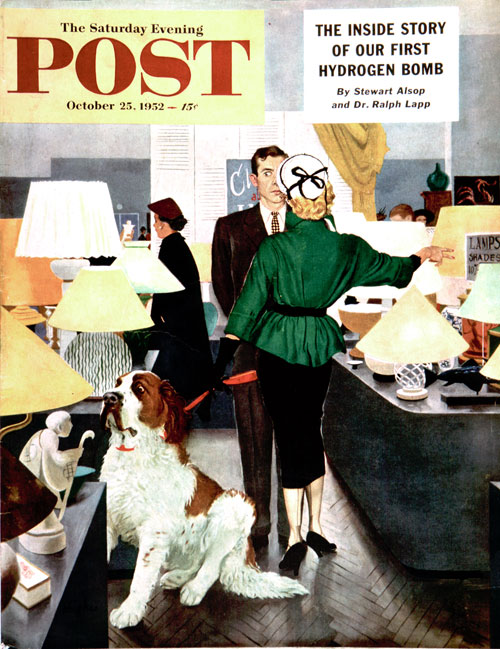
St. Bernard in Lamp Shop
George Hughes – October 25, 1952
Another frequent Post cover artist, George Hughes, clearly sympathizes with the nervous clerk in this painting from 1952. Editors noted, “it can be said in this lady’s favor that she would not take a bull into a china shop.” One swipe of Bernie’s tail would probably make the point moot.
Classic Covers: Sled Dogs or Dogs That Sled
It’s a classic Norman Rockwell cover from 1919. The boys are careening downhill on a sled, having a great ol’ time. But look at the dog’s face. Sheer terror!
Now, we could swear it was the same dog on a 1923 Country Gentleman cover by a prominent artist named J.F. Kernan. Did Rockwell lend Kernan the dog? If so, the mutt had taken to sledding in the intervening years. This one is going for the gusto!
Really, people should ask Fido if he wants to go for a sleigh ride. On a 1930 cover by artist Alan Foster, the boy and grandpa are having a great time, but the pooch is nearly as terrified as the Rockwell dog above. We wonder if grandpa made it all the way down the hill with his still lit pipe.
Sledding by sunset are the folks on the 1948 cover by artist John Falter. Reluctant to give up a great winter’s day, the kids are still at it. And yes, one little white pooch is still sledding (in a little girl’s arms).
The snowfall is so deep on artist John Clymer’s January 1954 cover that dad is up on the roof clearing it off. Junior, on the other hand, is enjoying the white bounty, taking the dog for a sled ride. This pace a dog can handle.
Our earliest sledding cover? This beauty from November 1900. The snow created a social event, with people trudging uphill greeting sledders going downhill. And, yep, there is a pooch in the center of the action, having a ball in the snow.
George Kernan
January 13, 1923
George Gibbs
November 24, 1900
Alan Foster
February 8, 1930
John Falter
December 18, 1948
John Clymer
January 23, 1954
Norman Rockwell
December 27, 1919
